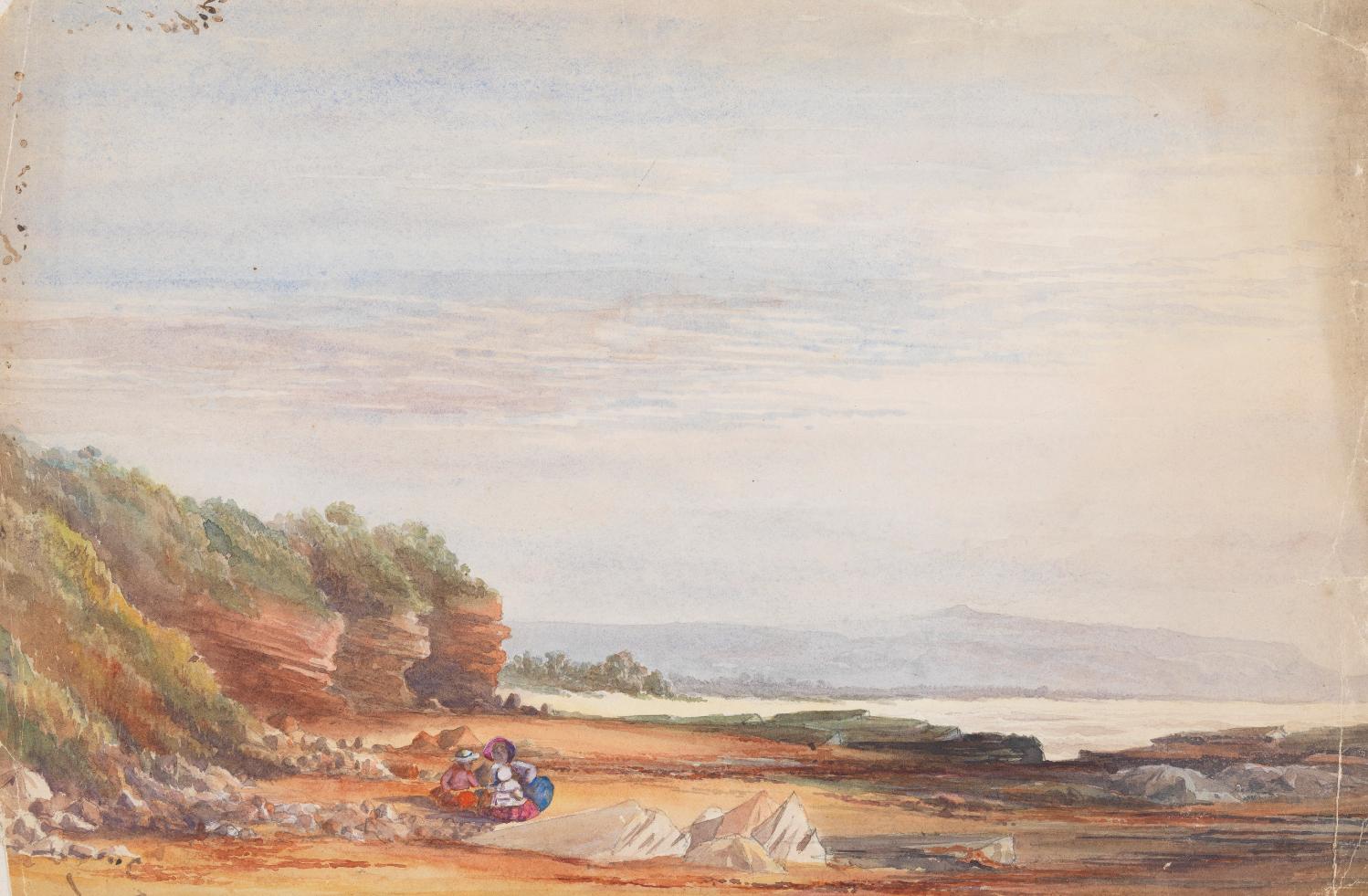A Pearl Of An Idea: Long Reef Aquatic Reserve Celebrates 40th Anniversary
LONG REEF— COLLAROY
(Contributed).
If you wish to see the beauty
Of a morning by the sea,
Beauty that has no excelling
In its wondrous witchery.
See the sun rise in its glory
Filling all your soul with joy,
Over stately, radiant Long Reef,
Long Reef at Collaroy.
In autumn, when dawn's silver
mists
Are floating out of sight,
And the birds wild clamor, shrilly
Once more bids good-bye to night.
Then the beauty that will gladden you
Is there "without alloy,
O'er ethereal looking Long Reef,
Long Reef at Collaroy.
O, bold headland gazing eastward,
Watching there to greet the sun.
And the ships that come to Sydney,
Do you know them — everyone?
Do you know the mystic language
That the crooning waves employ
As they break below your green crest
Long Reef at Collaroy.
I have gazed upon your beauty
At sunrise, and at noon,
Seen your glory in midsummer,
And in wistful, rain-kissed June,
And was filled with hopeful longing
That for years 'twould be my joy,
- To live o'erlooking Long Reef,
Long Reef at Coolaroy.
LONG REEF---COLLAROY (1940, March 14). Murrumburrah Signal and County of Harden Advocate (NSW : 1881 - 1947), p. 3. Retrieved from http://nla.gov.au/nla.news-article214489973
Member for Manly James Griffin and the Northern Beaches community will this weekend commemorate the Long Reef Aquatic Reserve, on its 40th anniversary, as a pivotal resource in marine education for all.
“The Long Reef Aquatic Reserve was declared as the State’s first aquatic reserve in 1980, a huge acknowledgement of the importance of this unique environment right here on our doorstep,” Mr Griffin said.
“From the shore from Collaroy rock baths south to Long Reef Surf Lifesaving Club and out to 100 metres offshore, the Reserve extends over 80 hectares, and has been described as a ‘living museum’, which provides more microhabitats for marine animals to breed than any similar area on the coast.”
Mr Griffin said the Long Reef Aquatic Reserve was protected for educational and scientific purposes to protect rocky shore plants and animals (invertebrates and cunjevoi), after marine life became seriously depleted due to intensive collection for food and bait over the years.
For more than 70 years it has been a focal point for marine education with thousands of school children, university students and the public visiting the aquatic reserve each year to learn about intertidal animals and plants.
“To our local community, the Long Reef Aquatic Reserve is valued and celebrated for a variety of activities including walking, exploring the rock platform, swimming, fishing, snorkelling, scuba diving, surfing and boating,” Mr Griffin said.
“Quite simply it is the pearl of marine education here on the Northern Beaches.
“The fortieth anniversary of the declaration of the Reserve is an exciting acknowledgement of the understanding and appreciation of the values of Long Reef Aquatic Reserve and its role in research and education, and as a valuable ecological pocket for the northern beaches community.
“Locals feel a great sense of pride and place for the Reserve, and the huge role it plays in marine conservation, with dedicated Fishcare Volunteers providing educational tours and encouraging the community to use and look after the area.”
Background: Why is Long Reef an aquatic reserve?
Long Reef has a wide variety of aquatic habitats:
- from high tide to below low tide
- different materials such as sand, rocky reef and boulder fields
- different exposure to waves such as surf-exposed ledges and sheltered rock pools.
This means there is also a wide variety of seashore animals and plants that use these different habitats.
Long Reef was described by Newport's Isobel Bennett, one of Australia’s pioneering marine biologists, as a ‘living museum’.
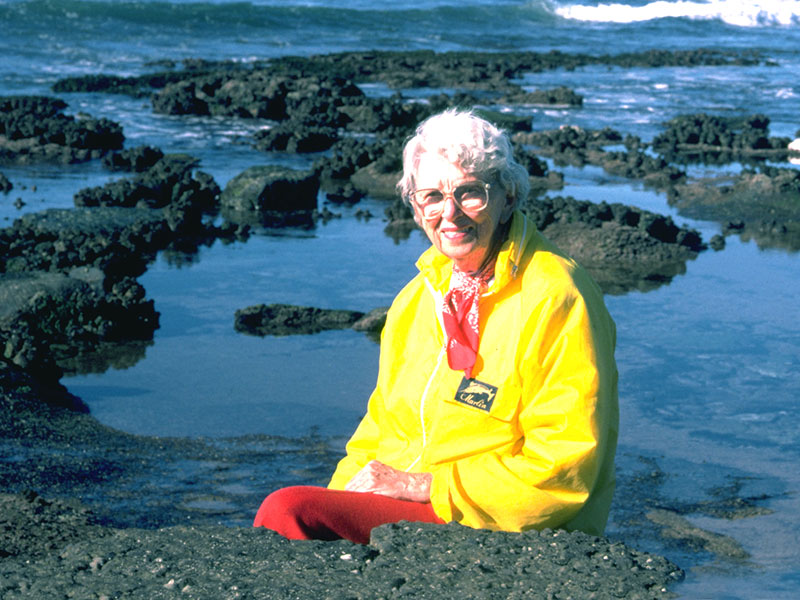
Isobel Bennett
By the 1970s Long Reef’s aquatic flora and fauna had become seriously depleted due to intensive collection for food and bait.
In 1974 a scientific team from the Australian Museum, including Isobel Bennett, Elizabeth Pope and Phil Colman began a campaign to protect Long Reef for scientific research and education.
Long Reef was declared an aquatic reserve in 1980
Forty years on, Long Reef has been the site of numerous scientific studies and is visited each year by thousands of school children, university students and the public, learning about intertidal animals and plants.
Objectives for Long Reef Aquatic Reserve
- conserve the biodiversity of seashore animals and plants
- protect habitat
- facilitate educational activities
- facilitate scientific research.
Many other activities can be enjoyed at Long Reef Aquatic Reserve, including snorkelling, diving, line fishing and spearfishing for finfish (fish with a backbone), surfing, boating, exploring the rock platform or just taking in the beauty of the area.
Since 1980, Long Reef Aquatic Reserve has played an important role in protecting rocky shore plants and animals, and has been an important place for marine education and research.
The reserve is an outdoor classroom, living science research site and recreation hub. It is a home for fascinating marine animals and plants.
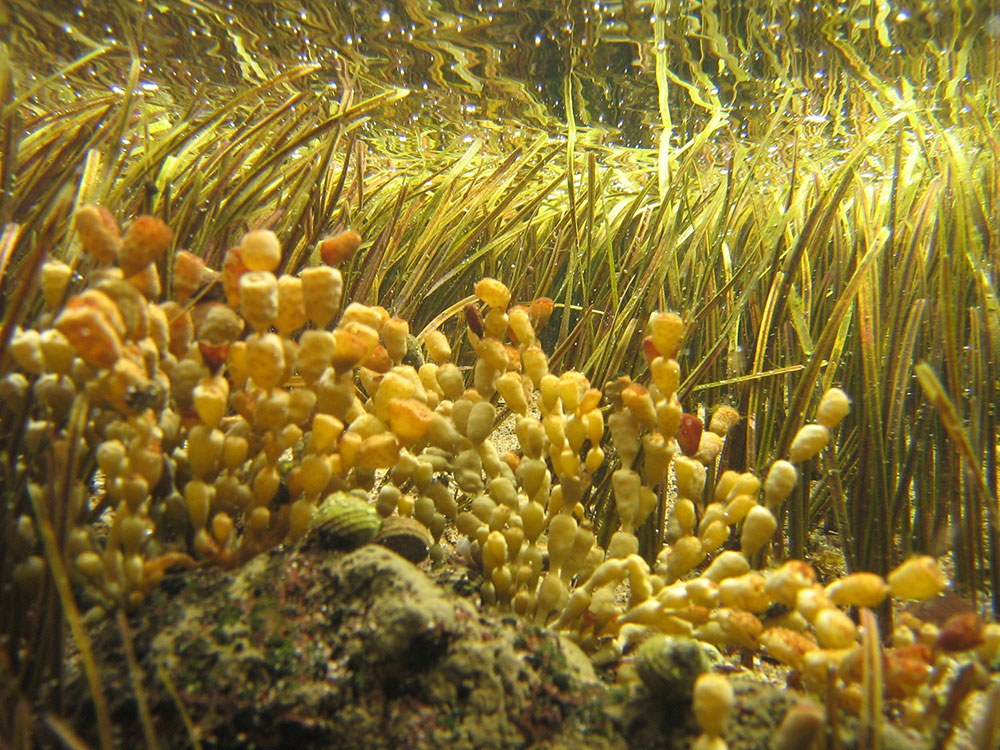
Zostera and Hormorsira- Neptune’s necklace and seagrass provide habitat for many different animals (credit Isobel Bennett) - Eelgrass (Zostera) is a type of seagrass, which are the only flowering plants that can live underwater. They grow in sheltered shallow waters in sand or mud anchored in the sediment by a root-like structure called a rhizome. Seagrasses are important habitat for many species of plants and animals.
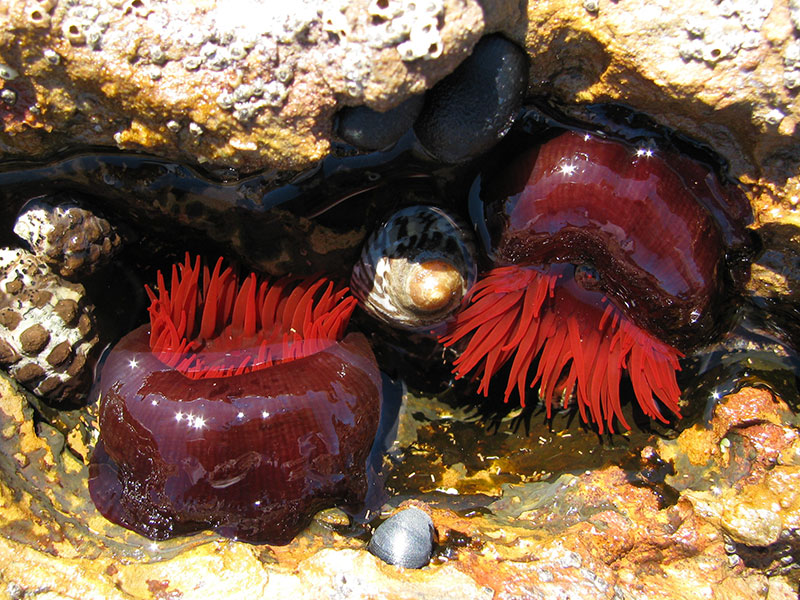
Waratah anemones are easy to spot at low tide as they look like maroon-coloured blobs, but when the tide comes in they open up to look like a rich, red flower. The ‘flower’ is in fact tentacles, which are armed with minute stinging cells. These tentacles reach into the water to catch food. Image courtesy Isobel Bennett
NOTIFICATION OF LONG REEF AQUATIC RESERVE
IN pursuance of the provisions of section 16a (1) of the Fisheries and Oyster Farms Act, 1935, the area shown by hatching on the diagram hereunder is hereby declared to be the Long Reef Aquatic Reserve.
(1263) J. R. HALLAM, Minister for Agriculture.
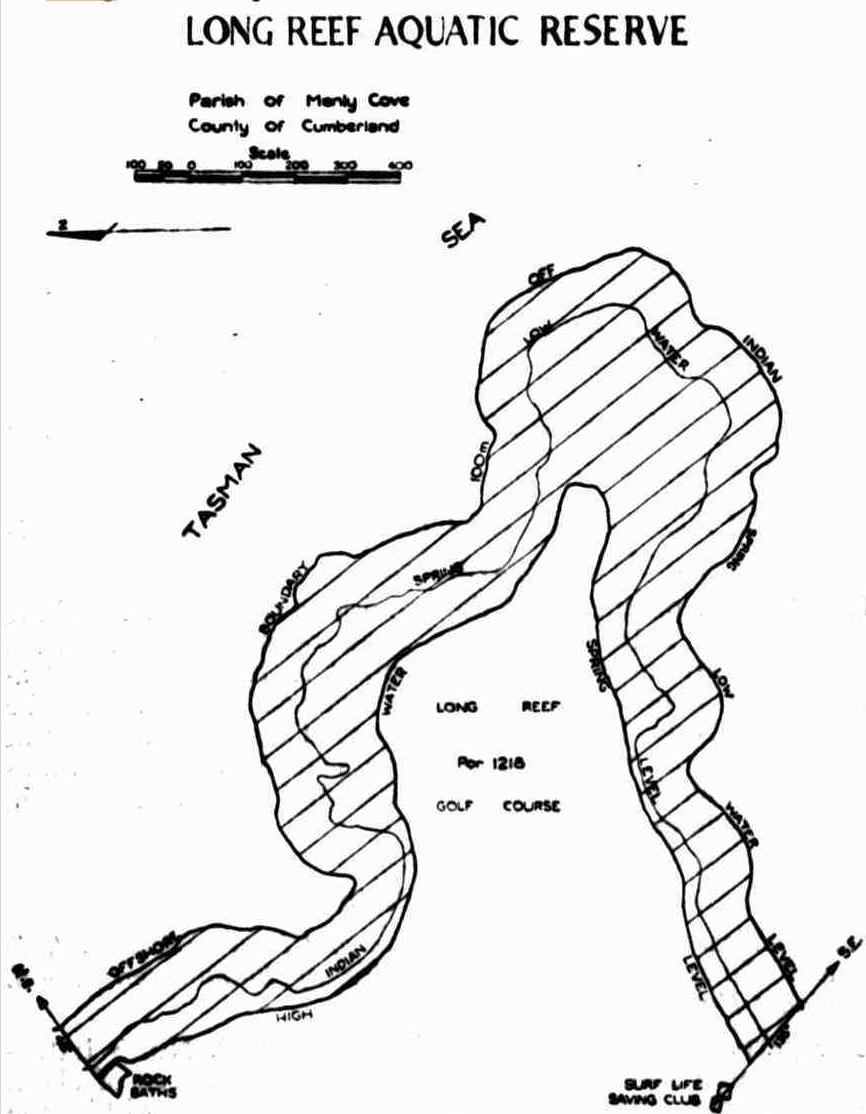
NOTIFICATION OF LONG REEF AQUATIC RESERVE (1980, May 30). Government Gazette of the State of New South Wales (Sydney, NSW : 1901 - 2001), p. 2787. Retrieved from http://nla.gov.au/nla.news-article231251611
Department of Agriculture,
Sydney, 17th September, 1984.
FISHERIES AND OYSTER FARMS ACT, 1935
Re-appointment of Long Reef Aquatic Reserve
Honorary Vigilance Committee
HIS Excellency the Governor, with the advice of the Executive Council, in pursuance of the provisions of section 7 of the Fisheries and Oyster Farms Act, 1935, has approved that the persons whose names appear in Schedule "A" hereunder be re-appointed to the Long Reef Aquatic Reserve Honorary Vigilance Committee in respect of the area described in Schedule "B" hereto, for a term expiring on 20th February, 1986.
J. R. HALLAM, M.L.C.,
Minister for Agriculture and Fisheries.
Schedule "A"
Jim Cooksey, 16 Beach Road, Collaroy.
Murray Curtis, 5 Florence Avenue, Collaroy.
Phil Lowe, 8 Essilia Street, Collaroy.
Lloyd Issaac, 11 Jamieson Parade, Collaroy.
Judith Colville, 20 Beach Road, Collaroy.
Anthony Reginald Pitkin, 25/33 Palamar Parade, Harbord.
Ian Sizeland, 36 Anana Road, Elanora Heights.
Schedule "B"
The Long Reef Aquatic Reserve as notified under section 16a(1) of the Fisheries and Oyster Farms Act, 1935, and published in Government Gazette No. 80 of 30th May, 1980. FISHERIES AND OYSTER FARMS ACT, 1935 (1984, October 12). Government Gazette of the State of New South Wales (Sydney, NSW : 1901 - 2001), p. 4992. Retrieved from http://nla.gov.au/nla.news-article231385974
Long Reef Insights
The name 'Long Reef' was in use by 1814. The land was granted in a 500 acre (202 hectares) lot to William Cossar, the Government's Master shipbuilder, who succeeded Thomas Moore in 1812 at the King's Dockyard. This stood on the western shore of what is now Circular Quay, roughly where the Museum of Contemporary Art is. Cossar held the post until 1821.
TRESPASS.-- Whereas daily Trespasses are committed on the Farm of Long Reef, the Property of Mr. William Cossar, by Horned Cattle, Horses, and Pigs:- All Persons are cautioned to keep the same off after this Notice, to prevent their being impounded. W. COSSAR. Classified Advertising (1815, June 24). The Sydney Gazette and New South Wales Advertiser (NSW : 1803 - 1842), p. 1. Retrieved from http://nla.gov.au/nla.news-article629134
Sydney. SITTING MAGISTRATE-R. BROOKS, Esq. Assize of Bread, the Loaf of 2lbs. 5d.
His Majesty's cutter Mermaid, Lieutenant KING, R. N. commander, will proceed on a voyage of discovery early in the ensuing week.
The government boat William Cossar, which was taken from hence some time since by a gang of runaways, all of whom fell victims to their rashness with the exception of a man named Smith (a gypsey), was yesterday brought back by His Majesty's colonial brig Elizabeth Henrietta, from the northward of Port Stevens. Sydney. (1819, May 1). The Sydney Gazette and New South Wales Advertiser (NSW : 1803 - 1842), p. 3. Retrieved from http://nla.gov.au/nla.news-article2178679
DEPUTY COMMISSARY GENERAL'S OFFICE,
Sydney, 24th April, 1819.
A LIST of Persons who have tendered SUPPLIES of FRESH MEAT for the Use of His Majesty's Stores, and from whom the Quantities expressed against their respective Names will be received at the different Stations herein mentioned.
AT SYDNEY.
When received | By whom tendered | Quantity | Residence.
May 15 |
Geo. Johnston, Esq. jun | 6000 | Annaldale
Mr. George Cribb | 6000 | Sydney |
James Meehan, Esq. | 6000 |
22
Mr. John Jamieson | 6000 | Coombsby
Mr. Isaac Nicholls | 4000 | Sydney |
Mr. Charles Tompson | 4000 | |
Colonel O'Connell | 6000 |
29
Mr. Samuel Terry | 6000 |
Mr. William Cossar | 3000 |
Mr. Andrew Byrne | 1000 |
Mr. Samuel Haslam | 1000 | |
Mr. James Squires | 1000 | Kissing Point |
Mr. Thomas Sylvester | 1000 | Sydney
Mr. John Andrews | 4000 |
Mr. George Crossley | 4000 |
June 5
John Piper, Esq. | 6000 |
Richard Brooks, Esq. | 6000
Henry Brooks, Esq. | 6000 |
12
John Oxley, Esq. | 6000 |
William Redfern, Esq. | 6000 | |
Robert Lowe, Esq. | 6000 | Bringelly
19
Mrs. King | 6000 | Europe
P. P. King, Esq. | 6000 | Parramatta |
Mr. Joseph Pye | 2000 | Eastern Creek |
Mrs. Mary Reibey | 3000 | Sydney
Mr. William Chalker | 1500 | Parramatta
26
D. Wentworth, Esq. | 6000 | Sydney
NOTICE. (1819, May 8). The Sydney Gazette and New South Wales Advertiser (NSW : 1803 - 1842), p. 2. Retrieved from http://nla.gov.au/nla.news-article2178687
Matthew Bacon purchased William Cossar's grants and by 1825 James Jenkins owned the land. James Jenkins arrived in Sydney in 1802 having been transported for stealing sheep but quickly propsered,along with his brother. He was an early landholder at Ryde and also in this area. Jenkins's eldest child Elizabeth inherited land from family friend Alexander McDonald at North Narrabeen in 1821. By 1825 James and his daughter owned all the foreshore land from Mona Vale down to Dee Why. Eventually the Jenkins family owned about 1,800 acres (728 hectares), the bulk of this being owned by the Salvation Army after Elizabeth passed away in 1900 per her wishes.
105. WILLIAM COSSAR, 200, Two hundred Acres, Parish of Manly Cove, commencing at the North-east corner of John Harper's forty acres, and bounded on the South by that farm by a line West sixty-four chains; on the West by a line North fifty chains; on the North by William Cossar's five hundred acres by a line East thirty chains to Dewy Lagoon; on the North by that Lagoon to the Sea ; and on the East by the Sea to the commencing corner.
Promised by Governor Macquarie on 21st August, 1821. Quit-rent 4s. sterling per annum, commencing 1st January, 1827. GRANTS OF LAND. (1832, October 31). New South Wales Government Gazette (Sydney, NSW : 1832 - 1900), p. 368. Retrieved from http://nla.gov.au/nla.news-article230389243
COLONIAL SECRETARY'S OFFICE, SYDNEY, 24th DECEMBER, 1833.
THE undermentioned GRANTS of LAND, advertised, on the dates specified, in the names of the original Donors, with a view to the preparation of Deeds, having been claimed by other Parties ;—Notice is hereby given to all Persons concerned, that the papers in the respective cases have been transmitted, for examination and report, to the Commissioners ap-pointed under the Act of the Governor and Council, 4 Gul, IV., No. 9, for hearing and determining upon claims to Grants of Land in the Colony of New South Wales, to whom the res-pective Parties are now referred.
Notice of 10th January, 1831.
NARRABEEN.
16. Robert Anderson Grant ............. No. 1 Claimant, Robert Henderson.
17. Richard Porter .................. Grant No. 2 Claimant, Robert Henderson.
18. Philip Schaffer .................. Grant No. 9 Claimant, Robert Mac Intosh.
...
89. William Cossar ................... Grant No. 105 Claimant, James Jenkins.
90. James M'Donald ................ Grant No. 106 Claimant, James Jenkins
Government Gazette Notices (1833, December 24). New South Wales Government Gazette (Sydney, NSW : 1832 - 1900), p. 532. Retrieved from http://nla.gov.au/nla.news-article230391262
COLLAROY
Landmark Disappears
PIONEER MEMORIES
(By J.G.L.)
Collaroy's oldest landmark is disappearing. A week or two hence and the last will have gone of the long, low cottage in which Miss Jenkins, a daughter of one of the earliest residents, ended her days about 16 years ago.
That was before Narrabeen had come into its own and before the latter-day people who took up a position on the southern end of Long Reef Beach, which is the chart name for the three-mile stretch of sand and blue water that runs from Twights to the headland on the north, decided upon a name of their own, and very naturally dropped on Collaroy. There was nothing else for it. Narrabeen was not then considered to be among the nicest places on the coastline. It was somewhat wild in more than one sense. Many of the old-time folk coupled it up with Clontarf and Chowder Bay, and passed right on to Pittwater, where there, was no suspicion and very little doubt.
THE OLD TRADER.
Collaroy got its name because one of the oldest of the Newcastle traders ran ashore in the small bay, a little to the south of the present surf sheds and house. The steamer was making for Sydney with a full cargo and lots of passengers, many of whom were returning after a successful race meeting on the Hunter. There was no excuse for the mishap. The night was clear and the sea quite calm. It was within an hour of daylight when the old paddle-wheeler came to an abrupt stop in the second line of breakers.
Some of the gear, of the steamer came to light only last week-end, just at time, as it were, to be in the same picture with the broken walls and the big, unlucky Norfolk Island pine which was chopped down one day recently because it happened to stand right in the centre of one of the new roadways which are being run through the old home grounds. A big current has torn the southern end of the beach to pieces, exposing a lot of anchor-chain, a big wooden pile used for one of the straining lines in the efforts to refloat the steamer, and a fire bar or two, which would probably have been thrown overboard to lighten the vessel. The fire bar, thick with rust and barnacles, I carried away home.
THE JENKINS HOUSE.
The old Jenkins home was built on the 314 acre paddock and bush lot on the western side of the main road. That parcel of land, with the balance on the sea side of the road, was originally granted to Mr. William Cossar by the Crown. A lot of the country, especially that portion over which the Long Reef golf course now runs, was under cultivation in those early days. Sheep were kept on the hilly land behind the old homestead. Some of the old mesh wire fence which ran round the sheep paddocks can still be found. Very soon now all traces of the Jenkins' efforts will be wiped away. Mr. Ben. Tabsley was another of the early workers, round Narrabeen. He grew wheat and maize on the flats near the seashore. I have not yet been able to trace the exact location where Mr. Tabsley did his pioneering.
FRUIT-GROWING.
Mr. Cyrus E. Fuller, well known in Sydney, Bible Depot and Christmas card specialist, also was among the early workers round about Narrabeen. He planted : a big orchard under the foothills, between Collaroy and Jenkins Streets, and made quite a success of the fruit-growing. About 30 years ago Mr. Twight, still a resident, leased the Fuller orchard, and carried on the business of growing Early Newington peaches and Lord Nelson apples, passion-fruit were natives on the area. After a big blow one could shovel up the fallen fruit. Mr. Twight says that he many a time sold extra quality Newington peaches at 6d apiece. Fancy prices were easily obtainable. Travellers to and from the Hawkesbury bought eagerly.
Traffic was by coach, cart, and sulky. Mr. Black had much to do with the coaching. He carried the passengers who were doing the round trip, via Windsor and Sackville Reach. Mr. William Maddock, an old city bookseller, did the hooking for that run. Two journeys were made each way every week. The Hawkesbury trip was always recommended to visitors from far afield. I remember selling tour tickets to Mr. R. A. Proctor, and also to the much-travelled Mr. Smythe, who was his agent at the time he toured the Australian capitals with his talks on astronomy.
PLENTY OF SPORT.
In those days gillbirds were plentiful, and much shooting was done. Fishing, too, was good both in the lake and outside, on the reefs. It was the sport that attracted Mr. Gordon and Mr. Dillon, two expert linemen, who built small homes near the present "bundy" site. Mr. James Wheeler, who is now the oldest resident in the district, was familiar with Narrabeen when the place was in its infancy. His father many a time sailed a big ballast boat down to The Basin, on the north side of Long Reef, and spent a week or two on his lakeside grant, away from the worries of the city to which he belonged. His business, I understand, was In the Blue Bell Hotel, somewhere in Phillip Street.
All the old hands know that it was possible, even in years gone by, to spend a very pleasant day at Narrabeen. I am told that two well-known sportsmen resident in Manly made a remarkable return after a day on the northern beaches. They had hired one of the creamy horse- vehicles to take them out and home. All went well on the return until the driver lost his balance and tumbled off In the sand by the roadside. Neither of the sportsmen or the ponies knew of the mishap until the driverless carriage pulled up at the livery stables within a short distance of the old-time pier. How the coachman got home I do not know. More than likely he put in part of the night on the Collaroy. For a year or two the vessel was the Saturday night home of many a "tramp" and fisherman. One of Sydney's most successful booksellers told me that he had a fore-cabin "possie" on more than one occasion.
All these old-time Items and Interest are disappearing fast. Collaroy and Narrabeen will shortly be numbered among the nearer seaside suburbs. All the old-time links are being broken. Who knows when the sea will again leave the connections which helped to lift the Collaroy over the sand-bar and out into deep water; or who will raise another Norfolk Island pine to stand on the landscape with the giant which for half a century cast its welcome shadows across the lonely home threshold where Miss Jenkins spent more than half her life? COLLAROY (1925, October 3). The Daily Telegraph (Sydney, NSW : 1883 - 1930), p. 7. Retrieved from http://nla.gov.au/nla.news-article245046727
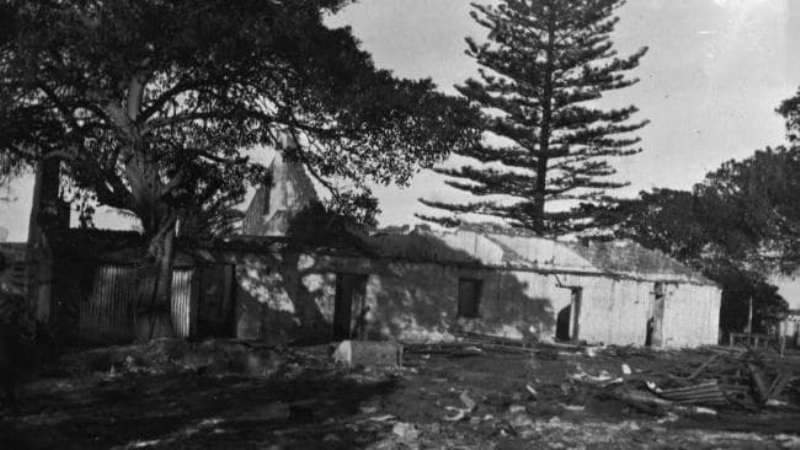
No 24. 'Ruins of Jenkin's home, Collaroy'. From album Historic pictures of Manly and Pittwater, 1856-1937 / compiled by Percy W. Gledhill, courtesy State Library of NSW
MIGHT HAVE HAD £250,000, BUT GETS £2/10/- A WEEK
Sydney- Man Who Fought Salvation Army for Ancestral Estate
THE ARMY'S "NO BEER" COVENANT.
SO passes the glory of the world — in a mist of Blood and Fire. It is as well for Phillip Jenkins that he is a philosopher. The Jenkinses are gone — save for him, and he is 72, and childless. The homestead, built a century ago to nurse a proud line of colonial barons, has crumbled under the hands of the demolisher. The erstwhile forest lands are bare grassy hills scarred with new roads, and the old farm fields sprout a harvest of houses. Flivvers buzz over the landscape, trippers, weekenders, outer-suburbanites and market-gardeners throng the fertile valleys, and the estate agent is everywhere. And only yesterday all was silence, all was solitude.
The Jenkins held sway over a thousand acres, another settler ran cows back in the hills, a former assigned servant of James Jenkins tilled his land a little way up the coast, and between there and Brook-vale there was no one else to trouble the sea, and the sky, and the sand, and the scrub. As Phillip Jenkins grew up, fishing off Long Reef, hunting in the hills, riding over the estate that passed to his aunt Elizabeth, who had adopted him when his father died, others came to the district. It was still a wild region, the newcomers were wild folk, and wild deeds followed. They will still show you the place in the bush behind Narrabeen where murder stalked one night, and tell you that a convict came there to find a brutal master of earlier times, and strike him down. They will tell you how many a man was "put away" in those dark times by neighbors ill-disposed, and hint at wild orgies in the "Narrer Bean Camp" of the blacks — so called from the long slender native beans that grew beside the lake there. This was Phil. Jenkins' environment, but he was not of it. Up in the old homestead he lived under the care of an eccentric maiden lady who saw sin in almost all things, but who husbanded carefully the estate her father had left to her care. Phillip never thought hut that he would be heir to the lands his grandfather had pioneered. It was early in last century when James Jenkins came from England and started a shop in Sydney. Later a land grant of 200 acres at Deewhy was made to him and to one, William Cossar, a grant was made of 600 acres situated to the north of Jenkins' land. Jenkins later bought Cossar's land as well as 188 acres known as Sheep Station Hill on the northern side of Narrabeen lagoon. On re-measurement in after years this land is shown to be 259 acres. When Jenkins died, over 900 acres passed to his three surviving children— Elizabeth, Martha, and John. The other son, James, had died, leaving his son, Phillip, another part of the original holding-, which he later lost.
In 1885 Elizabeth, the leading spirit of the three, became interested in the work of the Salvation Army and from time to time she made gifts of money and land to the institution. Finally, in 1894 she was instrumental in having the whole of the land transferred to the Army in return for an annuity of £175, and an undertaking to take over her liability in connection with certain bank shares which she held. Miss Elizabeth Jenkins died in 1900 and her will under which she left all her remaining estate, amounting to £120, to the Army also, was attacked by Phillip Jenkins on the ground of incapacity and undue Influence.
Evidence in the Equity Court showed that she was an eccentric woman. The Judge refused probate, which had been asked for by Brigadier John Hendy of the Army, who, with Thomas Coombs, had been appointed executors. On appeal to the Full Court in 1901 this decision was reversed, Hendy and Coombs being granted probate. If the will could have been proved invalid, an attack would have been made on the deeds of settlement. At the time the deeds were executed an understanding was reached between members of the Jenkins family and the Army that although the latter was legally entitled to assume possession of the property, nothing would be done to disturb Its condition during the lifetime of any member or the family. This agreement was observed by the Army. Nothing was done until John's death about 1911 — Martha had died many years before. The tramway to Narrabeen was built in 1911-12 and opened for traffic on Eight Hours' Day, 1912. On that day the Salvation Army held its first sub-divisional sale, when land adjoining Collaroy Beach averaged over £5 a foot. Conditions of that sale — and of all subsequent subdivisional sales— were that all fences erected must be approved by General William Bramwell Booth, and that the purchasers and the registered proprietors for the time being must not sell, permit to be sold, or connive at or be parties to the sale of any intoxicating liquors on the land. In addition, there was a condition in respect of the first sale prohibiting the carrying of liquor In the land.
Subsequently the Army applied to bring one part of the land, the area of which was 824 acres, under the Real Property Act, but the Crown claimed that Deewhy Lagoon of 62 acres, which was included in the application, was not a part either of the Jenkins or the Cossar grant. The present Chief Justice, sir Philip Street, sitting in Equity, held that the lagoon waters were not tidal, waters, and that they, were included in one or other or both grants, Followed an appeal, about 1910, to the High Court, which decided that the Crown was entitled to all the area from time to time covered by water. As Deewhy lagoon was continually being drained, the judgement that the ownership of the land would shift from the Crown to the Army, and vice versa, with the covering and uncovering of the land by water. The obvious difficulty of interpreting the ownership based on this unusual judgement resulted in a compromise being reached.
The estate, for the most part a narrow strip skirting the coast from Deewhy to Mona Vale, comprised originally about a thousand acres. The Salvation Army authorities have shown careful discrimination in in the manner of their throwing the estate open for sale, having regard to its value in the coming years as an aid to the Army's work. Large sums of money have been laid out in the developmental work— — in the construction of roads, bridges, etc. To date about two-thirds of the total area has been disposed of, and further sales are planned for the early future. On the estate the Salvation Army has established a colony for aged men, about 85 being in residence there: also a large Home for Boys. A section, at Collaroy, is set apart for the purposes of a seaside holiday ground — used, among, other things, as a fresh-air camp for poor mothers and children from the city and suburbs, also for children from various metropolitan Institutions. In addition It provides a summer camping ground for the Army's Life Saving Scouts and Guards and other young people. Then there are erected on the estate two Salvation Army halls —one at Deewhy and one at Collaroy. The Army has been generous in its gifts from the property for public purposes, such as recreation grounds at Dee-why, Collaroy, Narrabeen, and Mona Vale. In addition to the usual statutory area for reserves, it set apart for similar purposes - a strip, of foreshore extending from Narrabeen to Mona Vale. The popular Griffiths Park, comprising at 177 acres, probably the most attractive section in the whole district, was included in the original estate. Proceeds of land sales are credited to a central fund at headquarters, for the purpose of assisting in the erection of Institutions for the care of the friendless and needy, also halls in localities where it is not possible locally to raise sufficient funds. ' Further, one-third of the net proceeds of sales is devoted to the missionary operations of the Army, which are now well established in India, Burma, China, the Dutch Indies, Korea, Zululand, Nigeria, and Kenya, From Australia many Salvation Army officers have gone forth to these lands in connection with missionary service. In all this, the Salvation Army claims that the intentions of Mr. and Miss Jenkins, from whom the Army derived this property, are being observed both in spirit and In deed. Not one penny of the proceeds of the estate, Army officials make clear, is used for the personal benefit of any, but those for whose aid the Army
During the past two years (owing to expenditures required for development purposes) the Army has not benefited at all from the estate. But prior to that period, for some twelve years the proceeds of the estate have assisted the funds of the organisation to the extent of about £9000 a year. Meanwhile, Phillip Jenkins . is philosophical. He has a roof over his head, a few shillings to keep the wolf from the door, a few old friends, and a good wife. He has farmed his little block in the past, but now, getting on in years, and in poor health he sits on his verandah watching the golden lemons dropping off his trees for want of a payable market, rather like golden coins slipping from a man's hand. He is philosophical. If ever he does cry out against Fate, rate's answer, it seems, is a lemon.
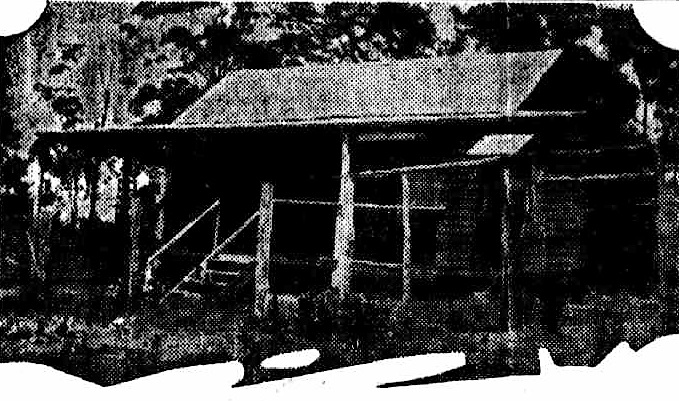
Phillip Jenkins' Cottage in the Narrabeen Bush
IN a weatherboard cottage in the bush at Warriewood, a few miles from Narrabeen, lives a man who, but for an old woman's whim, might today be worth, anything up to a quarter, of a million pounds. He is Phillip Jenkins, sole survivor of a family that settled in the district 100 years ago, and to-wards the end of last century owned, land from Narrabeen to Deewhy
THAT land was transferred to the Salvation Army by Phillip Jenkins' aunt, Miss Elizabeth, and approximately £108,000 has already accrued to the Institution from the sale of a portion of the property. Jenkins fought the Army at law and lost. Now, he receives from the Salvationists an annuity panning out at £2/10/- a week.
.jpg?timestamp=1534833646312)
PHILLIP JENKINS
MIGHT HAVE HAD £250,000, BUT GETS £210- A WEEK (1928, November 3). Smith's Weekly (Sydney, NSW : 1919 - 1950), p. 2. Retrieved from http://nla.gov.au/nla.news-article234382625
Visit: Roads To Pittwater - The Pittwater Road
DEE WHY BEACH MANLY
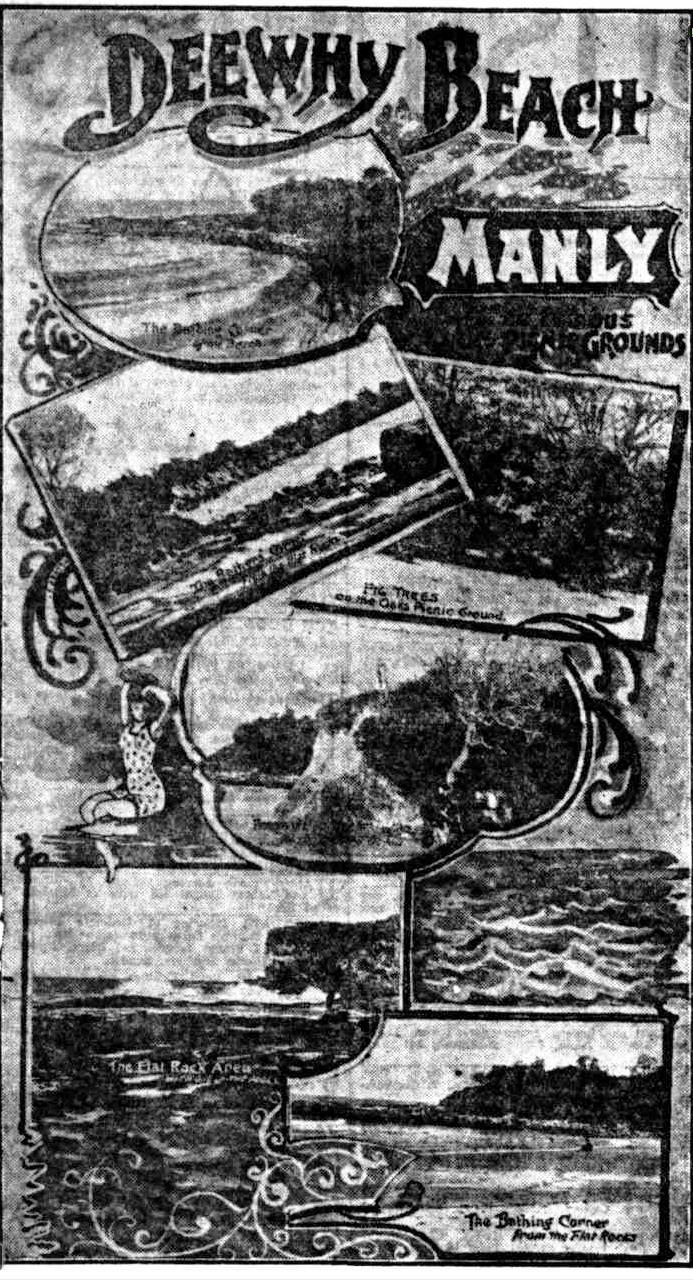
in Sydney's peerless necklace of ocean Jewels Deewhy Beach Is a brilliant gem. It Is one of the most beautiful spots between Manly and Narrabeen — about seven minutes' walk from Pacific Parade, which will shortly be connected by tram to Manly. Dee why Beach has long been' known as one of the choicest picnic resorts around Sydney, but the great .spreading movement which Is now taking place is about to cause this spot to be embraced by the builder, and to become on ideal place of residence for those who either wish to retire In peace to some scene of peace and beauty, or to those who love to spend their week-end where the water is bluest, the sand softest, the surf gentlest, and the air most invigorating.
This resort is now particularly in the public, eye because the famous Oaks Picnic Grounds, which have been known for years as one of Sydney's most attractive pleasure resorts, have been subdivided, and will on Anniversary Day be thrown open to the people for settlement. These grounds are beautifully situated. They are right on the beach front page at Deewhy Head, and command a scene where Nature reposes most gracefully. At the southern end, where the beach touches the estate, there Is fine shelter and a succession of flat rocks, amidst which are many clear crystal pools, admirable for bathing. From southerly busters or westerly gales It Is well protected, and those who make their homes here may enjoy all the pleasures of the sea side without any of its disadvantages.
For the angler this will make an Ideal site for a home, as the schnapper grounds are on the 100ft. reservation outside the eastern boundary, while Long Reef is opposite and Deewhy Lagoon lies at the back of the beach. The 100ft. reservation from the high-tide line enables one to ramble amongst the rocks to view the cliffs 100 to 120 feet high, to study the peculiar pot-holes 10 to 12 foot deep, and to enjoy in the shade the glory of the Pacific. Not only is Deewhy Beach a perfect place for the residence of the city man who, having been confined to his desk all the week, needs a week-end home by the sea, where it Is most restful, but It Is a fine spot for the squatter who would spend his summer at the seaside or the retired man who is seeking health and, peace.
Deewhy Beach Is really not a great distance from the city when one considers that the electric tram, when constructed will be able to land passengers to the Manly boat In fifteen minutes. The whole trip to and from Sydney is therefore well under the hour, but the main point Is that it Is a decidedly refreshing and enjoyable one. To the land speculator the Deewhy Beach Estate offers exceptional Inducements, for, judging by experience in regard to ocean frontages along this coastline, land values are bound to go rapidly ahead. Manly furnishes a striking example of what money can be made by In vestment In this direction. Land sold, only ten years ago from £10 to £15 per foot Is now worth from £30 to £100.. Manly's growing popularity Is bound, when the tram Is extended, to embrace Deewhy Beach, and there is little doubt that values will rise In similar proportion to those at Manly. A great crowd Is expected to attend the sale of the Deewhy Beach Estate on Anniversary Day, and Messrs. Horning and Co. have so provided that the trip may be a picnic as well as a business excursion. DEE WHY BEACH MANLY (1911, January 14). The Sun (Sydney, NSW : 1910 - 1954), p. 4 (FINAL SPORTING). Retrieved from http://nla.gov.au/nla.news-article221565666
Fishing at Collaroy, Long Reef and 'Fisherman's Beach, dates from pre European settlement times and was the occupation of many an early settled farmer. Visit:
- Narrabeen Prawning Times - A Seasonal Tide of Returnings
- Oystering in the Pittwater Estuary - Oyster Kings and Pearl Kings and When Not to Harvest Oysters
- Yabbying In Warriewood Creeks
- Eeling in Warriewood's Creeks (Includes A Short History of community involvement in environmental issues/ campaigns in and around Narrabeen Lagoon - 1974 to present by David James OAM)
- Narrabeen Lagoon And Collaroy Beachfront: Storms And Flood Tides Of The Past
- Careel Bay Wharf and Boatshed
- Pittwater Fishermen: The Sly Family Narrabeen Exploits and Manly Community Contributors: The First Surfboat at Manly Beach
- Pittwater Fishermen: Barranjoey Days Pittwater Fishermen: Great Mackerel, Little Mackerel (Wilson's Beach - Currawong) and The Basin
Even when tugs were sent out to try and pull the Collaroy Steamer off Long Reef, fishing was the preoccupation of many aboard at least one of the tugs sent:
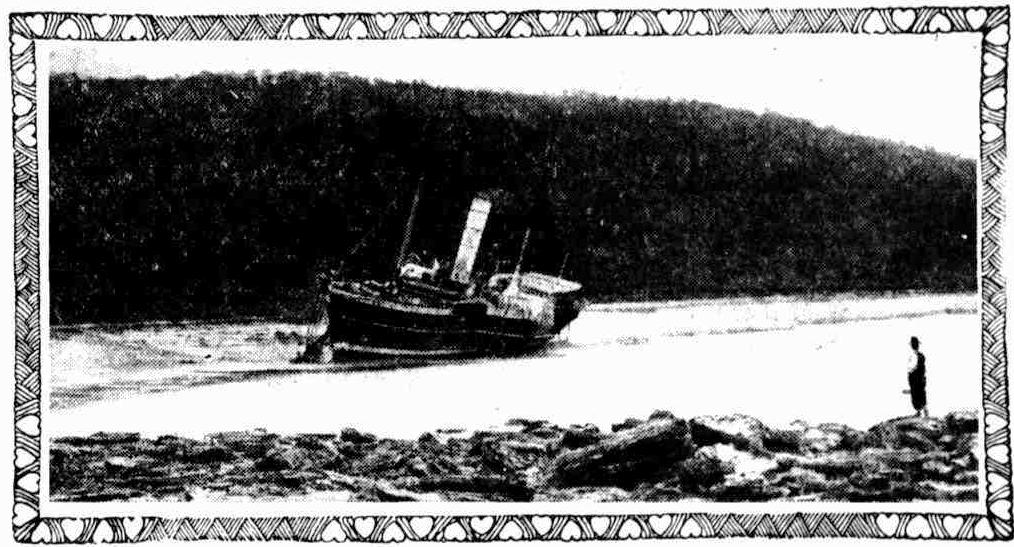
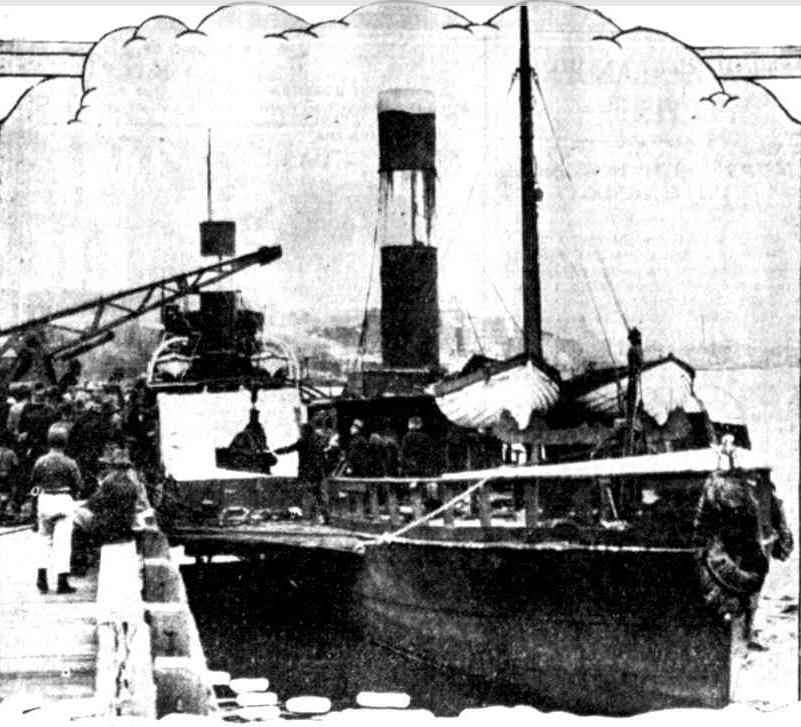
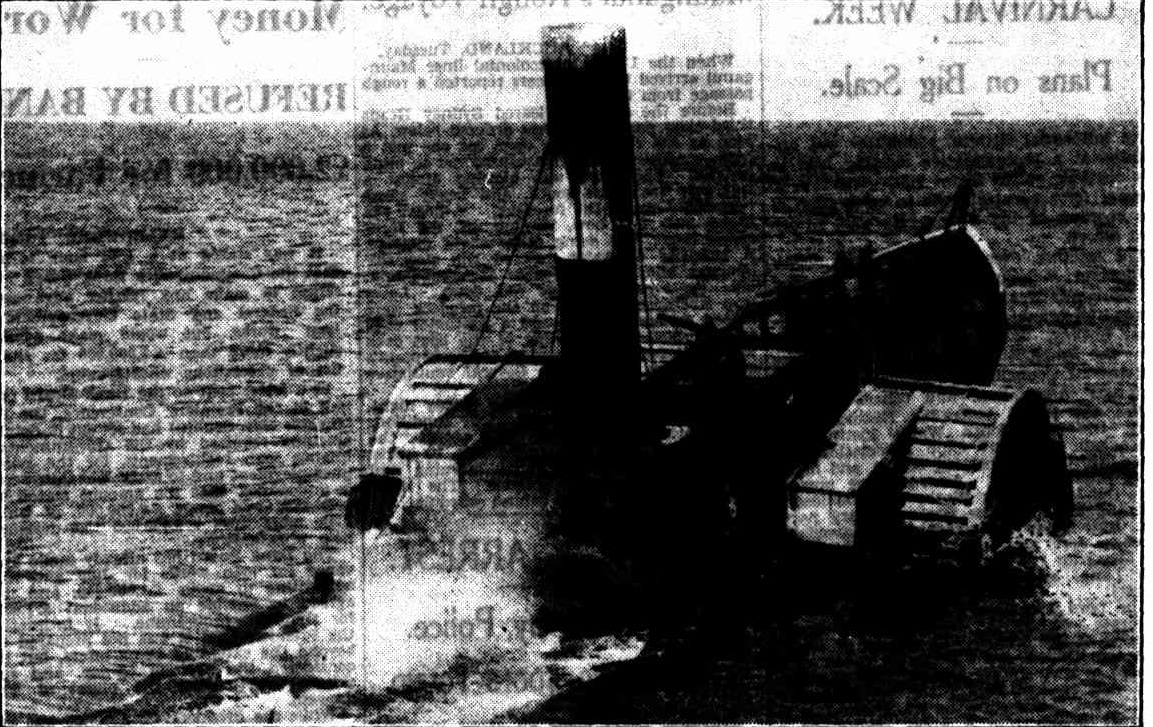
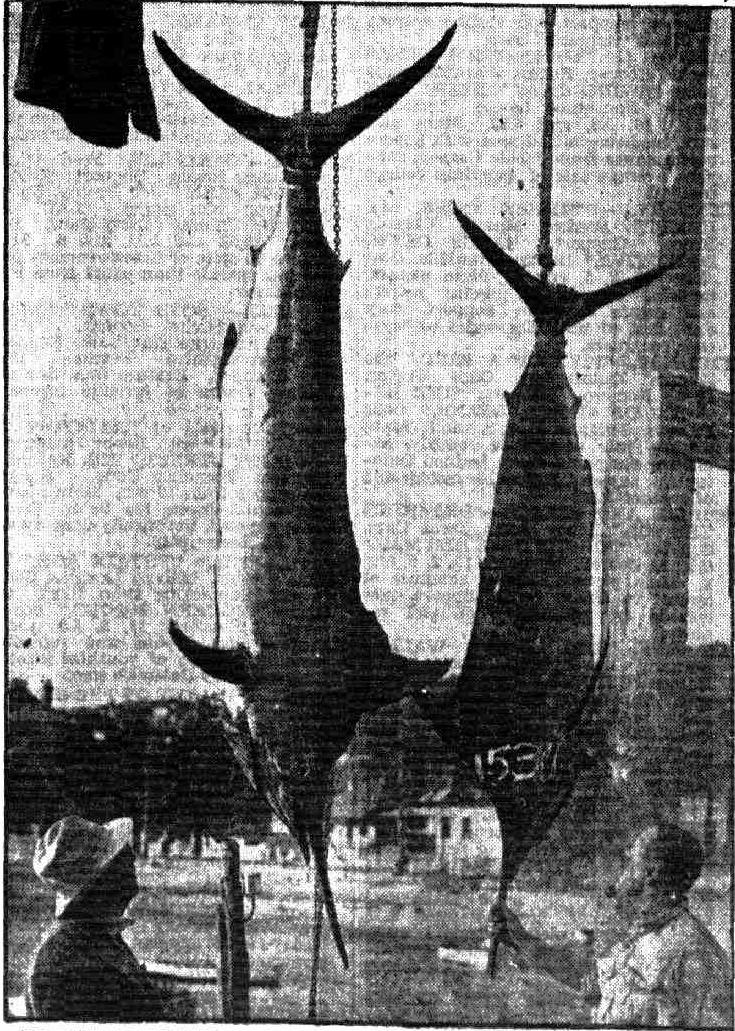
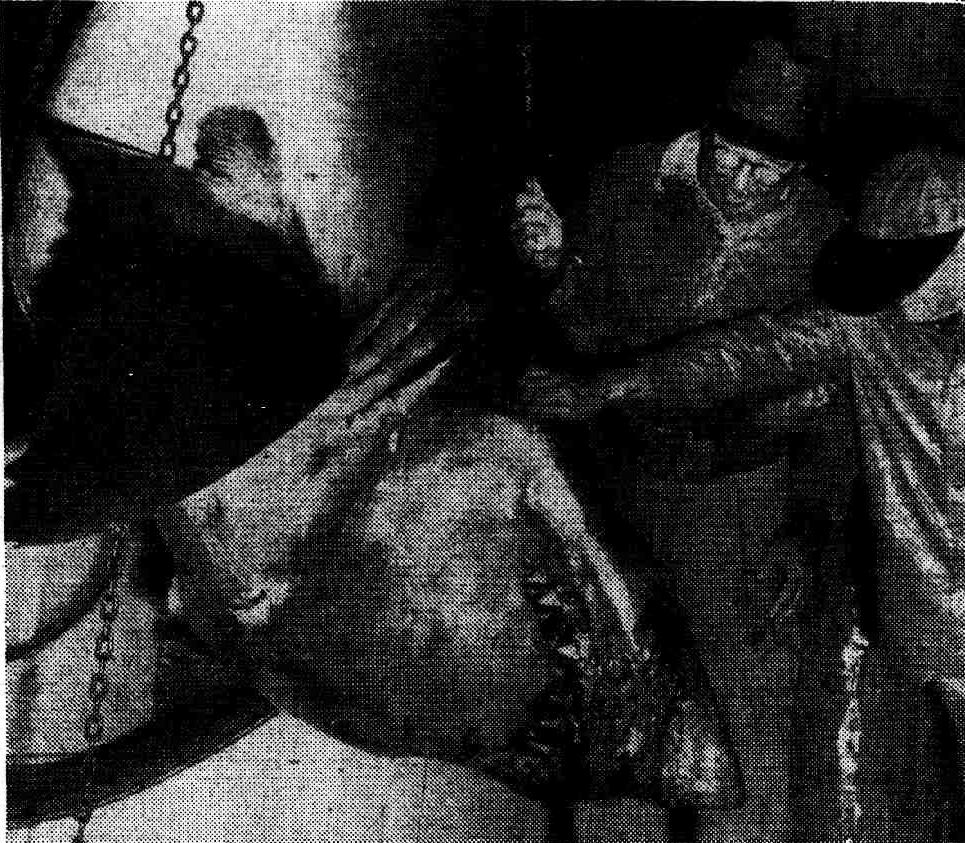
GEOLOGICAL CHANGES AT COLLAROY. SCENE AT THE SOUTHERN END OF THE BEACH.
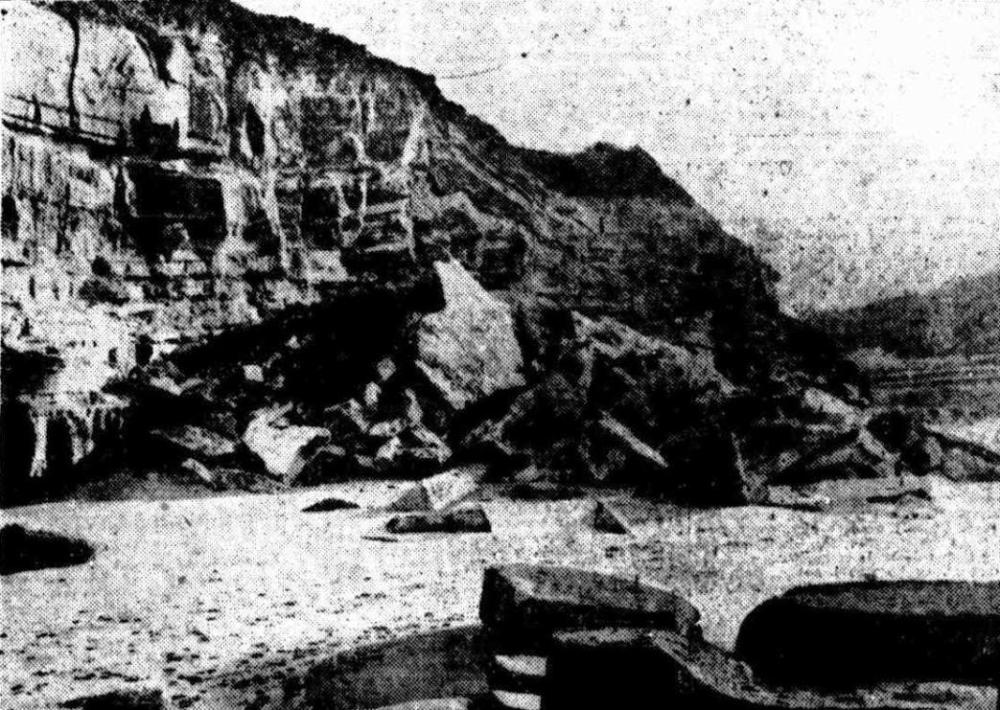
The Rev. R T Wade, of Killara, who forwarded to us the photography of which the above is a reproduction, writes - "The headland at the south end of Collaroy Beach consists of alternating beds of sandstone and shale. The lower beds, because of oxidation and other chemical changes, have expanded, and forced the upper beds into the small but well-marked anticline in the centre of the view." GEOLOGICAL CHANGES AT COLLAROY. (1925, April 13). The Sydney Morning Herald (NSW : 1842 - 1954), , p. 10. Retrieved from http://nla.gov.au/nla.news-article16212688
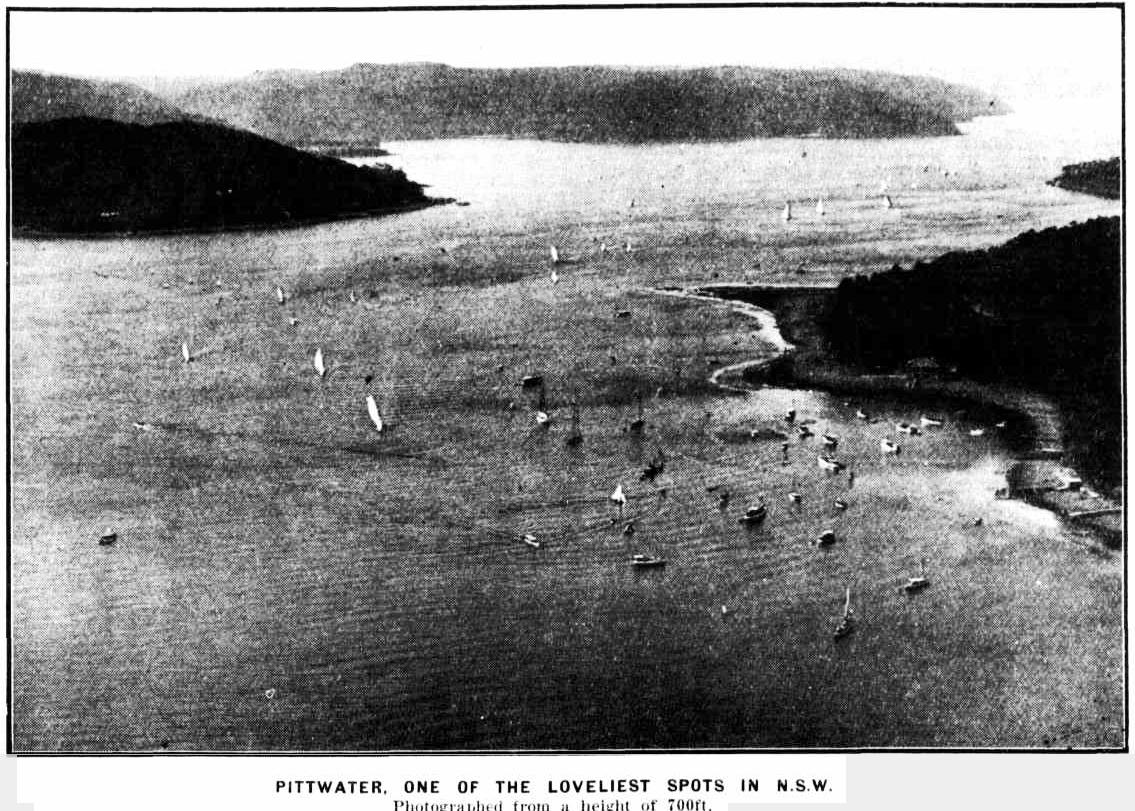
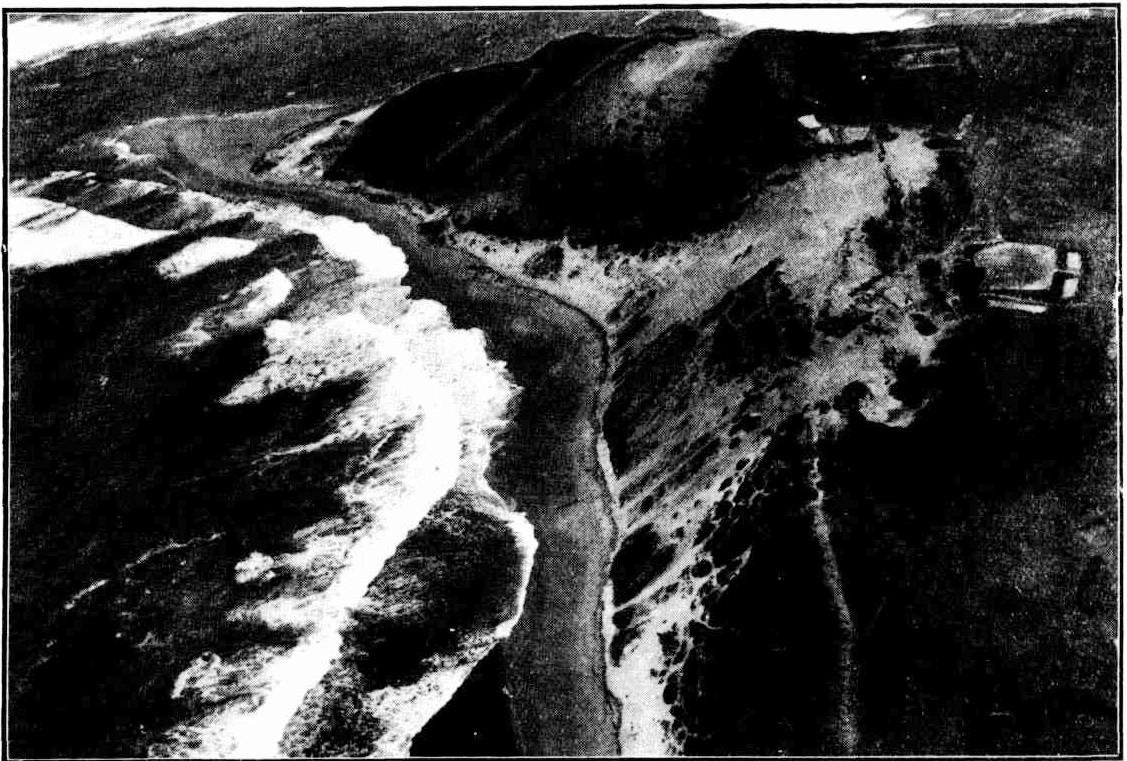
Timeline of Wrecks and Scuttled Ships in The Long Reef- Collaroy- Narrabeen area
1983 VERDIER, barge scuttled off L.R. as artificial reef.
1980 BELLUBERA, Sydney/Manly Ferry scuttled.
1977 HIMMA, tug scuttled.
1976 PYRMONT II, barge scuttled.
1976 DEE WHY, Manly ferry scuttled off Narrabeen.
1976 MEGGOL, oil barge scuttled off Narrabeen.
1948 HORN, Launch off LR.
1942 ALTAIR, Ketch north side.
1931 ECLIPSE, Steamer.
1920 CHRISTINA GOLLAN, Steamer four miles off L.R.
1919 SS MYOLA, Steamer founded.
1913 SS EUROKA, paddle steamer founded.
1894 GREYHOUND, steamer of LR.
1889 DUCKENFIELD, steamer L.R. north side.
1881 COLLAROY, Paddle Steamer hit reef and grounded Collaroy.
1877 SYLPHIDE, barque sunk off L.R.
1875 SUSANNAH CUTHBERT, schooner founded.
1868 MIMMIE, cutter L.R. south side.
1868 MOUNTAIN MAID, Brigantine off LR.
1865 ELLEN, schooner founded.
1865 AENID, Cutter.
1860 SWIFT, Ketch off LR.
1860 MESSENGER, schooner founded.
1816 WINDSOR, sloop.
Information : National Shipwrecks Database website
Some of these, apart from the more famous 'Collaroy' (Visit: The Collaroy Paddle Steamer: New Ephemera Added To Public Accessible Records - Her Connections To Pittwater ) grounding:
By High Road to Newport AND BROKEN BAY VIA MANLY.
(See illustration on this page.)
From Sydney to Manly, with its seven miles of water stretch, is a delightful trip. One always gets a regular and excellent steam service. A never varying series of pastoral laud pictures and rugged rock-heights come and go on the route],and enough of broad ocean is at hand, 'twixt head and head, to fulfil the conditions of an open sea trip. The picturesque scenery that skirts these aboard up north as far as Newport, Broken Bay, is the boast and delight of Manly folk, and the various stages plying to and fro to –that retreat daily are crowded with tourists from all parts of the colonies, who hold that the sigh of the Queen City of the South have not been "done" if this, wholesome watering place be missed. The tourist who steps on to the substantial pier at Manly has but a few step's to tread to reach a thoroughly-horsed stage, always waiting twice a day to convey him to the peaceful paradise facing the Pacific. –
“All aboard!" says the weather-beaten driver, .and a full coach and a fresh team scamper, to the tune of merry Jehu's whip, through the main thoroughfare of "our village." Villas and villas float past in quick succession, until the breath of ¡a pure Australian bush, mingled with scented, sea air, warns the pleasure-seeker that he has fairly commenced his trip to Newport. As the coach sweeps on to the turn leading to the high road, the eye involuntarily catches sight of a huge effigy of a kangaroo hewn from sandstone, and resting on a pillar of similar substance. This eccentric image is erected on a rocky elevation, and overlooks Manly far out into the sea. Its strange existence is in the scroll of Manly lore, and is ascribed to the-extraordinary humor of a mason who had too much time on his hand." In fact, he built it for pleasure, not for gain.
As the road shortens Curl Curl Lagoon is passed, and a rapid glance at the heights above reveals the famous Queenscliff Nursery Dairies and Chinese gardens are met with next, and, as an evidence of the presence of the former, the milch cow pastures by the wayside in peace and plenty. The made road to Queenscliff, or Ocean View, branches hereabouts.
A winding road and a quick turn brings in a deserted habitation which local legendary lore labels "The Haunted HOUSE " This place has a history. It is reported that its last tenant would neither leave it nor pay his rent. The landlord, whose patience for months was overtaxed, decided to be freed of this bad tenant; so he "fired" him out as an aboriginal would " fire" an opossum from a stump. The grimy stone walls of the house now alone remain, and are guarded in strange contrast by the ghostly murmurings of four stately cypress trees. Houses on the roadside appear at lengthened intervals as the destined distance lessens, and the bush foliage, studded with singing feathered life, manifests its plenitude on either side of the roadway. The beautiful lakes of Narrabeen are next encountered.
As the coach pursues its onward march; numberless fish are to be seen jumping in and out of the water, and are the only apparent motors that agitate its placidness. Long Reef, in the vicinity of which the good ships Collaroy and Duckenfield foundered, is close at hand. Its three or four miles of incomparable beach is watered with peaceful regularity by as blue a span of ocean water as can well be imagined. In this locality, too, a streak of sand cuts the shore waters, and forms what is known as the DY picture. The bleak spray from the rollers here is at times as dense as a winter mist. Further on a 4-acre plot of land is being cleared, it is said, for the purpose of supplying a reformatory in connection with the Salvation Army. The land, it is further understood, is the gift of a philanthropic maiden lady residing in the district.
Rocklily is next met with, and discloses a number of orchards, farms, an hotel, and two churches(Anglican and Roman Catholic). Religious service is not, however, too often held in the locality. Ministerial visits occur about twelve times a year.
The Bay view-road turns off a little further on, and a run of some three or four miles furnishes a wealth of wild scenery. Towering gums, box, and ti-trees mingle here in abundance with cabbage trees, and palm, and fern growths. At Church Point, the terminus for the stage, a fine view of Broken Bay is disclosed. Scott Island, which is said to be a Government grant to its present holder, rises in the near distance, and evidences a wealth of rude vegetation. Lion Island; which takes its name from a similarity in form to the king beast, keeps everlasting vigil at the bay entrance, and is plainly visible at this point. Erected on the point is a small wooden church devoted to the Anglican body, and at its rear is a small cemetery which contains five or six graves. John Redman, aged 78, and Mary Olliver, aged65," as the headstones read, tell, doubtless, that two old residents of the district lie here. The school house which is in close proximity, is in charge of Mr. Morrison, and cost 850 pounds. Returning to the main road, another four miles or so bring the tourist to his destination. What a fairy spot it is-this Newport! Churches, post and telegraph offices, settlers' houses, a school, a hotel, and a huge boarding-house tell of the growing importance of the place. A fine substantial wharf here receives produce for the various villages in the district, and at certain intervals large ocean steamers carry excursionists from the city to enjoy the lavish scenery that surrounds the haven. Looking far into the bay the course of the graceful Hawkesbury is seen winding its way through the rugged headlands and graceful glens that cluster near its shores. Of the many miniature bays that cling round the shores of Broken Bay none has so much peaceful grandeur and natural beauty to reveal as Careel Bay. Its waters of beautiful blue are snugly protected by ponderous heights, whose facings shoot forth vegetation of gaunt, green growth. The fisherman here plies his calling with profit to himself and pleasure to his market. Pleasure boats, too, float on the placid waters of Careel, and no true excursionist leaves Newport without visiting the subject of our illustration.
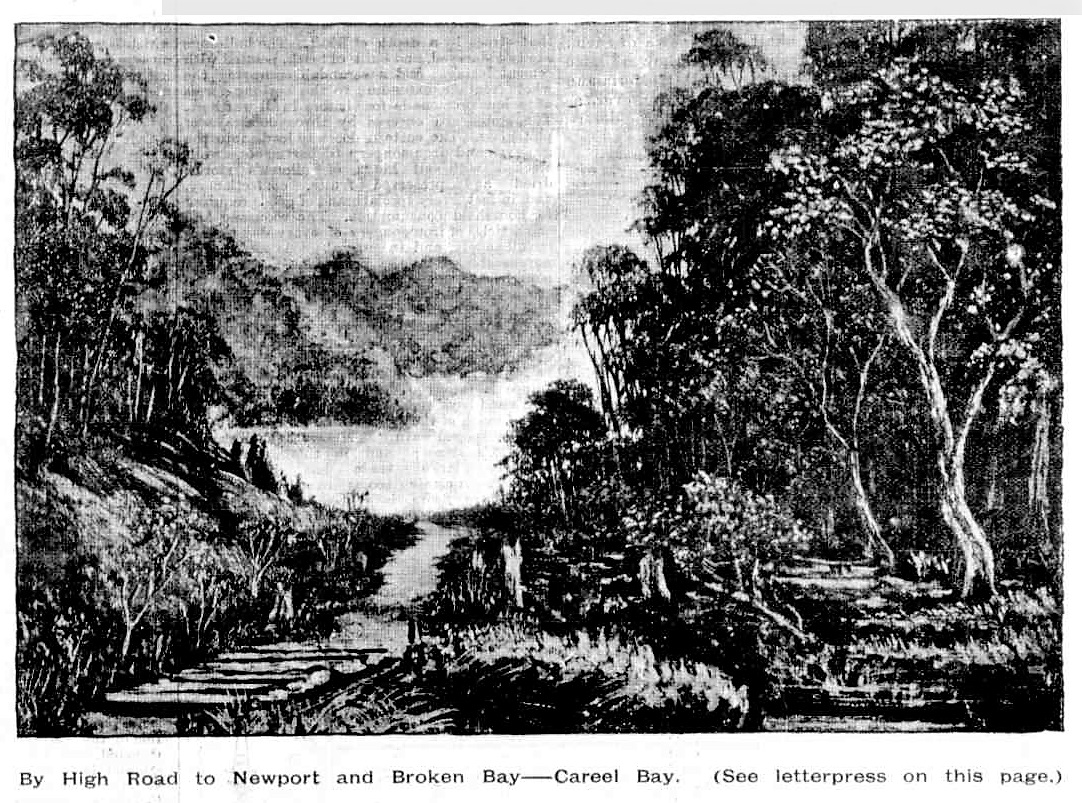
By High Road; to Newport and Broken Bay---Careel Bay. _ (See letterpress on this page.)
By High Road to Newport. (1891, January 3). Australian Town and Country Journal (NSW : 1870 - 1907), p. 34. Retrieved from http://nla.gov.au/nla.news-article71247615
LOSS OF THE S.S. GREYHOUND.
A report was made at Sydney on Monday by Captain D. Callaghan respecting the loss of the North Coast Steam Navigation Co.'s steamer Greyhound. He states that the vessel collided with some floating wreckage about six miles N.N.E. of Long Reef. Some of it got foul of the propeller, and brought the steamer to a standstill, while one of the stern plates was started, and the water gained so rapidly that the crew had no alternative save to take to the boats at once, which they did just in time to save their lives. They landed safely at Little Manly. The Greyhound was a wooden vessel of 59 tons register, and was only recently purchased by the North Coast Steamship Co. LOSS OF THE S.S. GREYHOUND. (1894, May 10). The Mercury (Hobart, Tas. : 1860 - 1954), p. 2. Retrieved from http://nla.gov.au/nla.news-article13305043
MARINE BOARD.
LOSS OF THE S.S. GREYHOUND.
The Marine Board met at their offices, Circular Quay, yesterday afternoon, when there were present -Captain Hixson (president). Captains Broomfield, McLean, O'Sullivan, Moodie, and Jenkins, Mr. Wildridge, and Commander Linderman. The board gave their decision in the matter of the loss of the s s Greyhound, on the 4th instant, midway between Sydney and Broken Bay. The finding of the hoard was as follows :-" That the said loss was caused by the vessel suddenly springing a leak, and thereby foundering, notwithstanding the efforts of the crew to keep her afloat. No evidence was adduced upon which to found a charge of default against Daniel Callaghan, the master." MARINE BOARD. (1894, May 22). The Sydney Morning Herald (NSW : 1842 - 1954), p. 3. Retrieved from http://nla.gov.au/nla.news-article13952178
Launch of a Steamer.
A large party of ladies and gentlemen assembled at Rowntree's Dock on Saturday morning to witness the launching of a new steamer built for Messrs. Allan and Hunter, of Balmabi. The new vessel, which will be used for harbour and outside fishing excursions, has a length of 105 feet overall, beam 21ft. 6in., and a moulded depth of 9ft. She is copper fastened throughout, with hardwood bottom and kauri topsides. The engines were built by Messrs. M'Kay and Baxter, of Glasgow, and are capable of developing a speed of 13 knots.
Special attention has been paid to the comfort and convenience of passengers, of whom it is expected the new steamer will accommodate a bout five hundred comfortably. The electric light is to be fitted throughout, and when finished the vessel will form an acceptable addition to the harbour fleet. As she left the ways Miss Barter, a granddaughter of one of the owners, christened her Greyhound II. The builders expect to hand over the vessel in a few week's time.
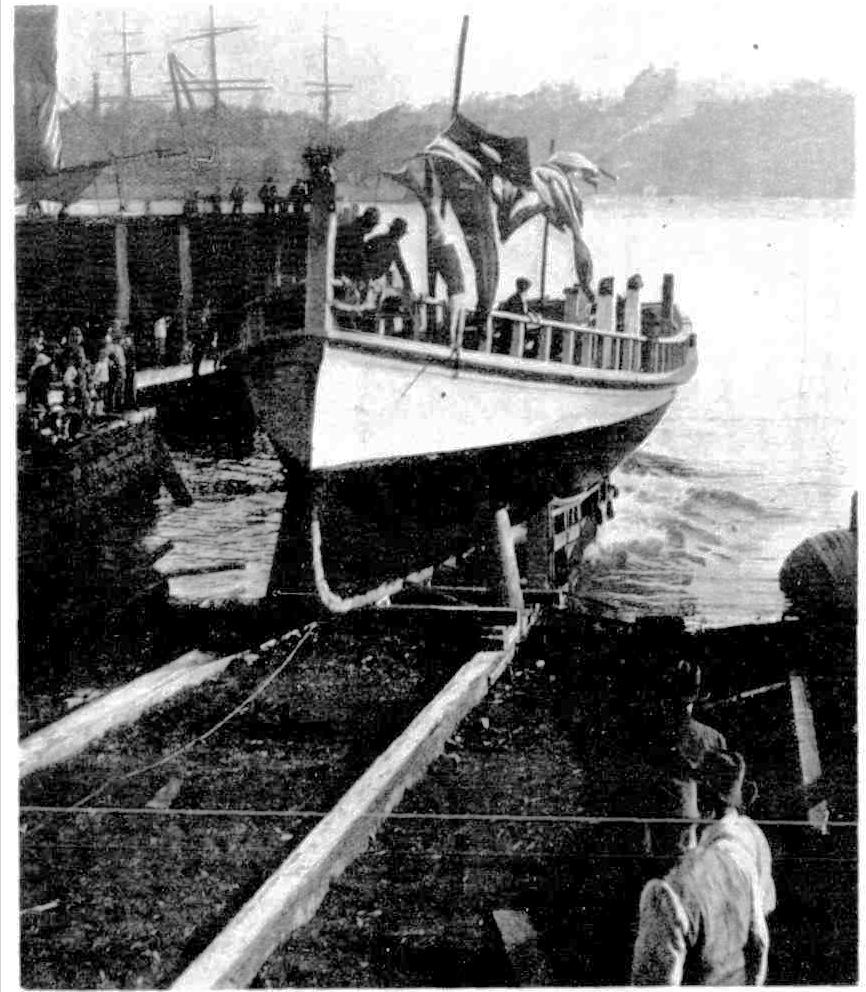
LAUNCH OF NEW STEAMER GREYHOUND II. Built for Allan and Hunter at Rowntree's Dock, Balmain.
Launch of a Steamer. (1902, June 14).The Sydney Mail and New South Wales Advertiser (NSW : 1871 - 1912), p. 1505. Retrieved from http://nla.gov.au/nla.news-article163819188
FISHING.
To-day. — A.F.A., schnapper trip to Coalcliff. July 5,— Burwood Club, competition, Parramatta River. Several parties that visited Cowan, Hawkesbury, and Woy Woy during the week obtained only very small catches, and their reports are of a gloomy character. This is attributed to the cold westerlies. Fish leave their haunts on the flats and shallows when the water becomes Intensely cold for the deeper channels.
The A.F.A. schnapper excursion In the Greyhound to-day for Coalcliff and Bellambi Reef filled well, Twenty-five members booked for the outing. Some fine hauls should be made if the weather proves propitious, which is usual for this time of year with the wind of the land. The Burwood Fishing Club have arranged a competition for the fifth proximo on the Parramatta River, for Mr. W. Harris' trophy. An open competition for the month of July ha» been promoted by Slick Simmons, of the Haymarket, on a liberal scale, open to all anglers, entrance free. First prize, a sliver-mounted pipe and fishing lines to the value of £3 3s; second prize, fishing tackle value £2 2s. The prizes are exhibited In the windows at the Haymarket, and the following conditions are to be observed:— Competitors may fish anywhere within a radius of 20 miles from Sydney. Only edible fish captured on rod or handline will count, and they must be obtained In a sportsmanship manner. Four days are allowed each competitor, viz., from Monday to Fridays, from 8.30 a.m. They must weigh result of catch up i» 5.30 p.m. on those days. On Saturdays the same applies, but from 1.30 to 9.30 p.m. Competitors weighing 1n the greatest number of edible fish la accordance with the provisions laid down by the new Fisheries Act shall be declared the winners. Messrs. Westenhagen and Thomson captured 10 tailer, weighing 20 lb., and on Thursday lost 40 of the same species were obtained at the Quay, with bait of boiled mutton. Johnson and party at Middle Harbour caught 90 black fish. J. Brown at Moore's wharf hauled 49 black fish ashore. The semi-final of the A.F.A. billiard tournament resulted in D. Hart and J. Spencer qualifying for the final, which Is to be played off to-morrow evening, at the rooms. Two schnapper weighing 20 lb. each, were captured at North Head on Thursday. Black fish, tailer, and mackerel, are reported to be biting well at Watson Bay, and off Garden Island.
Barracouta 3ft. long were caught in numbers off Cremorne, Neutral Bay, by several anglers on deep sea liners moored in the bay on Thursday and Friday last. It is seldom, if ever that they have been captured before in the harbour, although they have been occasionally caught off Coogee and elsewhere. These fish abound In Bass Straits, and there is no difficulty in catching them, as they take with avidity the "red rag" trailed in the water.
The Keira's schnapper party at Long Reef obtained 300 fish, varying from 9lb, down. The Woy Woy's party to Bird Island mustered 200 fish. Eastway's Long Reef excursion in the Greyhound totalled 120 schnapper kind. A private party on Thursday off Coalcliff in the Greyhound hauled on board 200 fish, the largest scaling 91b. A party from Woy Woy Journeyed in the steamer bearing same name to Catherine Hill Bay, and reported a large haul. The Neutral Bay Schnapper Club left last night for Wollongong, where they board the Xaiora, today, on a schnapper excursion to the Five Islands.
Next Wednesday Eastway's half-day trip to Long Reef in the Greyhound will take place. Fresh Prawns -in "Bytqik" are reliable; anglers very successful; big catches with "Bytqik;" in tins, 1s, 1s 9d, 2s 9d. FISHING. (1903, June 28). The Sunday Sun (Sydney, NSW : 1903 - 1910), p. 3. Retrieved from http://nla.gov.au/nla.news-article230032678
SUPPOSED WRECK. NEAR LONG REEF.
SYDNEY, Sunday.
A man named Boyle, who lives at Narrabeen, reported to the Manly police late this evening that he had sighted wreck-age about a mile off Long Reef, five miles north of Manly. He stated that through the glass the wreckage appeared to be the top of a mast, and the top of the derrick of a collier. They were sticking four or five feet out of the water. The police transmitted Boyle's message to the pilot station. It is probable that a boat will be sent to the scene of the supposed wreck at daylight. SUPPOSED WRECK. (1913, March 10).Newcastle Morning Herald and Miners' Advocate (NSW : 1876 - 1954), p. 6. Retrieved from http://nla.gov.au/nla.news-article136819527
ON THE- ROCKS NEAR NARRABEEN.
THE PADDLE-WHEEL STEAMER EUROKA ON SHORE AT LONG REEF, NEAR NARRABEEN. It will be seen that the vessel is flying a distress signal.
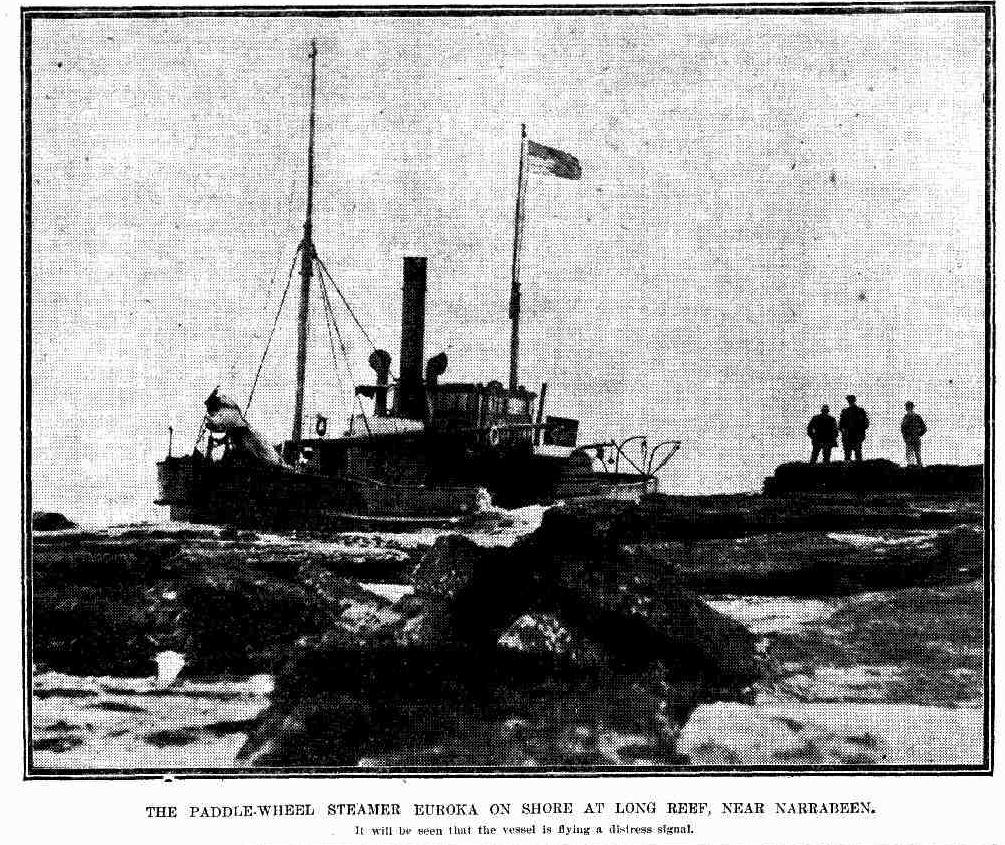
ON THE ROCKS NEAR NARRABEEN. (1913, October 21). The Daily Telegraph (Sydney, NSW : 1883 - 1923), p. 9. Retrieved from http://nla.gov.au/nla.news-article238903437
WRECK OF THE EUROKA ON LONG REEF.
THE SEAS WERE YESTERDAY BREAKING OVER THE ABANDONED VESSEL.
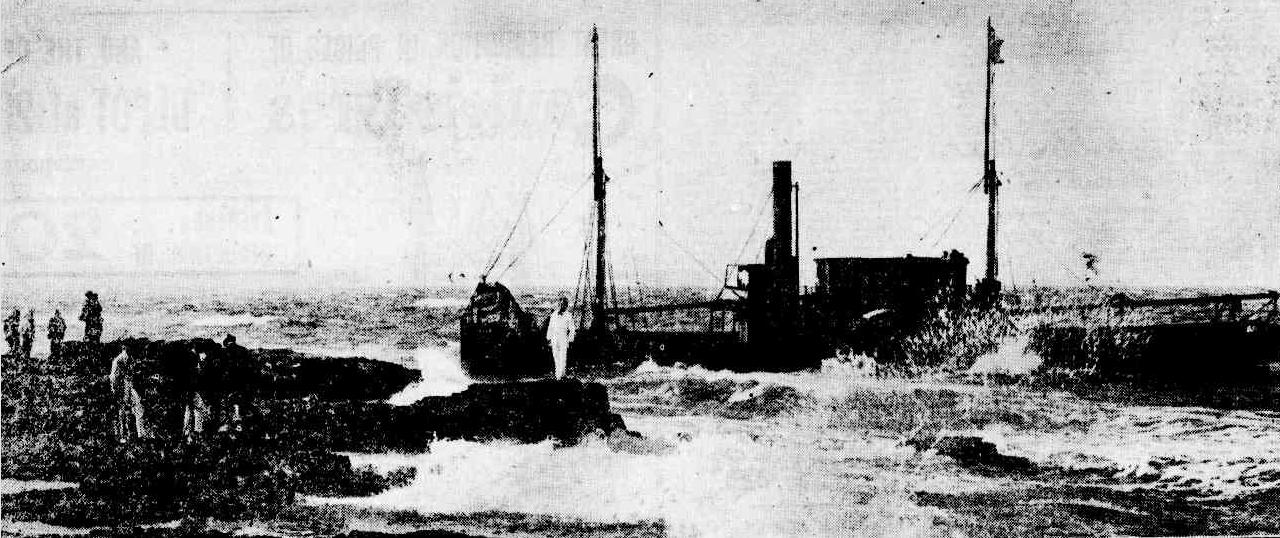
WRECK OF THE EUROKA ON LONG REEF. (1913, October 21). The Sydney Morning Herald (NSW : 1842 - 1954), p. 5. Retrieved from http://nla.gov.au/nla.news-article15459177
LONG REEF WRECK.
HUNDREDS OF PHOTOGRAPHERS.
Barely, has a wreck been so much photo-graphed as that of the Euroka at Long Reef. The little vessel is lying in such a fine position for the man with the camera that it is a clear invitation to the photographer. Last Sunday and Monday it appeared as if every second visitor carried a camera. One photograph was taken from sea on Sunday. A tug approached within about 50ft, of the wreck, and a splendid view of the vessel and the people on the reef must have been obtained. Several men in bathing costumes swam out to the stern of the Euroka and clambered aboard without difficulty, the sea being calm, but they did not find it so easy to land again on the rocks, and there were some barnacle-branded bodies showing after the feat.
The swimmers took a good deal of risk in diving into the broken and deep water, because it is the home of the: huge octopus and conger eels, and the deeper water often reveals huge and active sharks.
By the look of things the purchasers of the wreck have been proceeding in a rather leisurely fashion. No attempt to land the coal had been made up to yesterday, and it was reported locally that it was proposed, to transport it into a punt to be brought round from Sydney. LONG REEF WRECK. (1913, October 28).The Sun (Sydney, NSW : 1910 - 1954), p. 8 (FINAL EXTRA). Retrieved from http://nla.gov.au/nla.news-article229354387
CASUALTIES.
FISHERMAN DROWNED.
A fisherman, named Joseph Fino, from Collaroy Beach, met his death yesterday while out fishing. Fino went out with another fisherman, Charles Johnston, and when about four miles out the boat capsized. Johnston swam ashore, and reached land in an almost insensible condition. The Captain Cook went out, and recovered the boat, but found no trace of Fino. Johnston stated that the last he saw of him was when he was seated on the upturned boat. Fino was a native of Italy. CASUALTIES. FISHERMAN DROWNED. (1915, October 6). The Sydney Morning Herald (NSW : 1842 - 1954), p. 14. Retrieved from http://nla.gov.au/nla.news-article15617625
COLLAROY FATALITY.
Sir.— I have been requested by the Collaroy Beach Progress Association to bring under your notice the facts in reference to the attempted rescue of the unfortunate fisherman last Monday evening.
A resolution was carried at the Association meeting commending both junior and senior members of the Surf Club for their prompt and heroic attempt to rescue. Immediately the capsise took place a scratch crew of the junior members (lads about 16 years old) attempted to get the boat out, but the heavy seas were too much for them and the boys had to return, completely exhausted by the, effort.
When the senior members arrived home from work a second attempt was made, and just as the boat cleared the beach the Captain Cook rounded the points. We regret that our boys failed, but we are proud that they have in them the stuff that heroes-are made out of.
Collaroy Beach. — GEO. COHARNES. COLLAROY FATALITY. (1923, January 17). Evening News (Sydney, NSW : 1869 - 1931), p. 6. Retrieved from http://nla.gov.au/nla.news-article118811439
TUG SUNK OFF LONG REEF YESTERDAY.
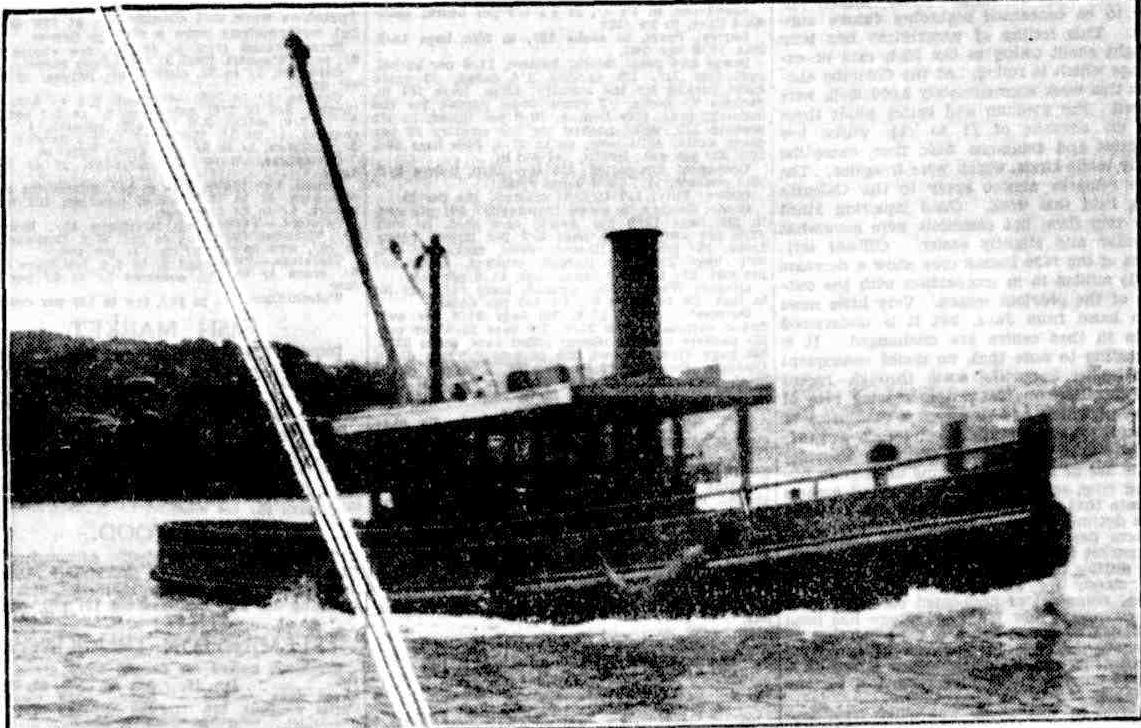
The steam tug Eclipse, which struck a submerged object in the dark, and sank almost immediately. The crew barely had time to take to their boat. TUG SUNK OFF LONG REEF YESTERDAY. (1931, January 17). The Sydney Morning Herald (NSW : 1842 - 1954), p. 16. Retrieved from http://nla.gov.au/nla.news-article16746576
FIRE THRILL
ON BLAZING LAUNCH DIVE TO SAFETY
LONG REEF SENSATION
A launch caught fire when the engine exploded about a mile and a half out at sea from Long Reef, between Collaroy and Dee Why shortly before three o clock this afternoon. The launch, which was about 30ft. long, was burnt to the water's edge, and it sank. The men tried to extinguish the flames with tins of water, but finding they could make no impression, they turned their attention to saving the nets, lines, and other property. The flames, however, spread rapidly, and they had to swim to their dinghy.
Fear of Drifting
Without oars, they were fearful of drifting out to sea. In the meantime the smoke arising from the burning launch was seen by Beach-Inspector Burke, of Dee Why. With Messrs. M. Moore, S. Moore, L. Moore and W. Orr, of the Doe Why Life Saving Club, he set out! to succor the men. A second boat in which were Billy Hughes and Percy Sargent, fisherman, was not far from the canal a third boat also joined in the rescue work.
Shark on Scene
While the rescue boats were nearing the scene, a shark appeared and cruised about for a while, but it disappeared when the craft closed in. One of those who first saw the blazing launch was Robert Lockley, of Stuart-street, Collaroy, who was at Long Reef. He immediately telephoned the Narrabeen police. Constable Huckins hastened to Dee Why on a motor cycle. FIRE THRILL (1931, March 24). The Sun (Sydney, NSW : 1910 - 1954), p. 9. Retrieved from http://nla.gov.au/nla.news-article224664990
LIFE LEAP
Launch Afire at Long Reef
6.30 a.m. THRILL
TWO Italian fishermen had to leap for life into the icy cold water when their fishing launch caught fire and sank near Long Reef, Collaroy, shortly after 6.30 a.m. to-day. Antonio Alae and Bob Macchla, from Woolloomooloo Bay, had Just reached Long Reef when the engine backfired and burst into flames. Despite the desperate attempts of the fishermen to extinguish the blaze, it spread rapidly and in a few minutes the launch was afire from end to end. The two men, realising that they could do nothing more, dived, fully clothed into the water just before the craft sank like a stone. For a quarter of an hour the men struggled in the freezing water before being rescued by another fisherman Antonio Macdia, who were returning to Sydney in another launch. They were taken to the Hornby lighthouse, where the keeper Mr. McFadyen, provided them with dry clothing. LIFE LEAP (1932, March 21). The Sun (Sydney, NSW : 1910 - 1954), p. 7 (CRICKET STUMPS). Retrieved from http://nla.gov.au/nla.news-article229892455
COLLAPSED AND DIED ON BEACH
George Baker 70 of Malcolm St.,Erskineville collapsed and died at Collaroy Beach yesterday. Police were Informed that Baker, a age pensioner, was camping in a tent at Fisherman s Bend, near Long Reef. COLLAPSED AND DIED ON BEACH (1937, November 13). The Labor Daily (Sydney, NSW : 1924 - 1938), p. 1. Retrieved from http://nla.gov.au/nla.news-article237763109
LAUNCH CREW SAVED BY COLLAROY SURF CLUB
SIX LIFESAVERS' GALLANT FEAT.
SYDNEY, May 19-Rowing more than 1000 yards in heavy-seas, whipped by a 60 /m.p.h. gale, members of the Collaroy Surf Club to-day risked their lives to rescue a small motor launch…owned by Harold Linn, of Randwick, and James Giilimore of Redfern in distress, off Long Reef. The 18ft. launch, in which they and four other men left Rose Bay on a fishing trip at 10.30 a.m. to-day, and when two miles off Curl Curl Beach, engine trouble' developed and, driven by heavy seas, the launch drifted rapidly northward.
.At 4.30 p.m. it was seen by residents of Collaroy to be less than a mile from shore, and heading toward the dangerous surf near North Collaroy. Six surf club members manned a surf boat, and after an exhausting and perilous struggle against wind and surf they managed to reach the launch.
A piece of anchor rope, the only gear in the launch not washed overboard, was thrown to the surf-boat, and pulling against a strong current for an hour and a quarter, the lifesavers towed the launch into Fisherman's Bay, but when it was almost reached the tow rope broke, and it was quickly dragged seaward by the undertow. One of the 'surf-boat crew dived overboard and swam-60 yards to reach more lines to the launch, and it was finally beached at 6.30 p.m LAUNCH CREW SAVED (1946, May 20).Cairns Post (Qld. : 1909 - 1954), p. 1. Retrieved from http://nla.gov.au/nla.news-article42495417
BATTERED LAUNCH DRIFTS ASHORE AT LONG REEF
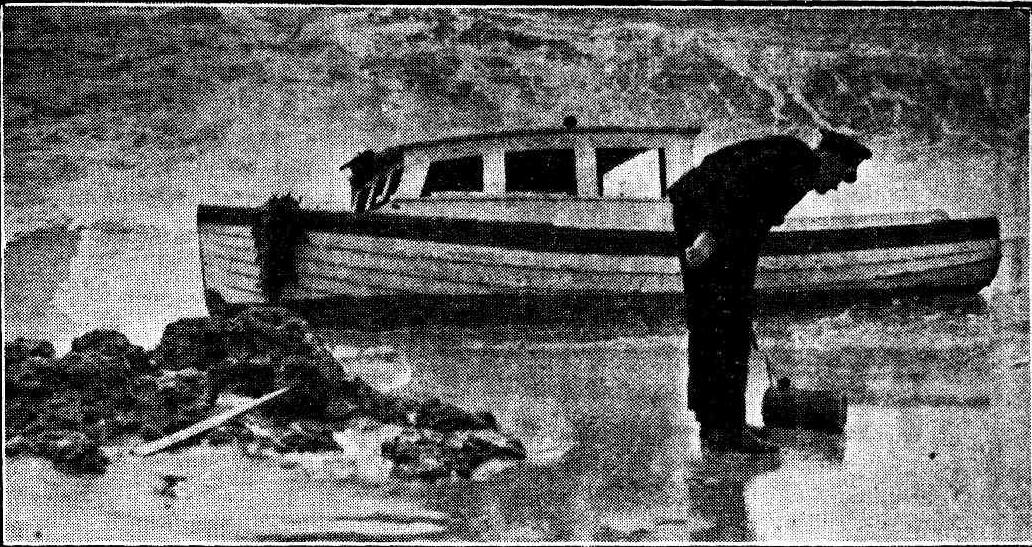
SURF-BEATEN launch where it drifted ashore near Long Reef yesterday. The launch capsized half a mile from the shore. A woman swam to the beach, but a man companion is missing.
Search For Seaman Missing After Capsize
Police and civilians searched the beach and rocks near Long Reef until late last night for a man who has been missing since a launch capsized early yesterday afternoon. The missing man is Ivan Archer Plummer, 23, merchant seaman, of Melbourne. The only other occupant of the launch, Miss Lavendar Joan Fosbery, 27, Macleay Street, Potts Point, swam and drifted on a plank for half a mile through heavy seas before reaching the shore.
About noon yesterday a man rang Narrabeen police and reported that a launch, without any occupants, was drifting ashore on the Dee Why side of Long Reef golf course. Senior-Constable Adams and Constable Adrian went to investigate. As they approached the beach they saw Miss Fosbery struggling from the water. Planned Harbor Trip Constable Adams said Miss Fosbery told the police she and Plummer had hired the launch from Messenger's Boat Shed, Double Bay, about 3 p.m. on Thursday, to go for a trip on the Harbor. -Near the Sydney Heads the engine failed, and the launch drifted rapidly out to sea. There was no food or water on the launch. When it got dark Miss Fosbery and Mr. Plummer attempted to attract attention by lighting flares made of twisted newspapers. They dropped anchor and spent the night at sea in the cabin.
At dawn the launch was off Manly. Miss Fosbery had a watch, and calculated they would drift on to the shore at Long Reef by midday. "Engine Still Dead" "As the launch drifted on to Long Reef, Plummer told me he was a good swimmer and I told him I could swim," Miss Fosbery told police-"The launch was flooded and the engine was still dead. "The launch capsized when the first big wave hit it about half a mile out. "I grabbed a plank and started for shore. I saw Ivan in the water. "He was about 40 yards behind me. "He had his overcoat on when we capsized. "He yelled out something but I could not hear. "I think he was telling me to keep on going. "I did not see him again." Police took Miss Fosbery to friends at Collaroy, where she was given a meal and then went to bed. The launch drifted ashore at the north end of Dee Why Beach. BATTERED LAUNCH DRIFTS ASHORE AT LONG REEF (1946, October 19). The Daily Telegraph (Sydney, NSW : 1931 - 1954), p. 5. Retrieved from http://nla.gov.au/nla.news-article248405075
However, it is the beauty and wildlife associated with Long Reef that remains obvious and uppermost in recollections and reports, past and present:
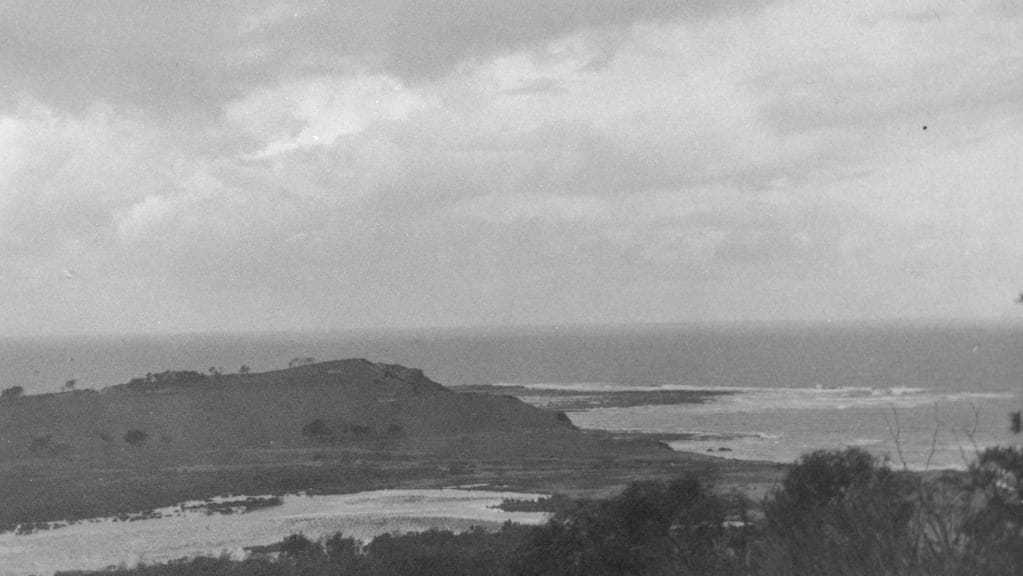
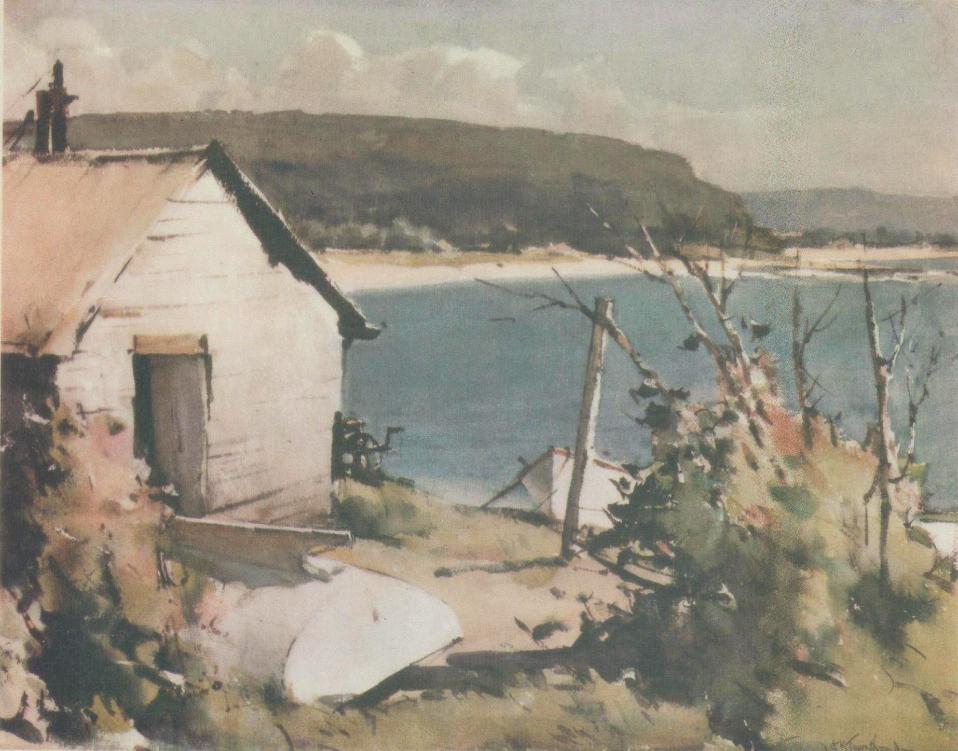
Mr. Lloyd's Fishing Shack at Long Reef. Painting by G K Townshend - courtesy 'SavaLloyd'.
Dad's Fishing Shack At Long Reef
Dad, Wilfred Henry Lloyd, was a Licenced Fisherman with his boat on the beach at Long Reef. He had an old mate named Charlie Proudfoot, father of Wally, who used to go outside fishing with him. I can remember him bringing Kingfish home, that were taller than me and big Jewies too. His favorites were Teragalin.
Mum used to work at Ernie Hookham's Haberdashery at Narrabeen Terminus. So Dad used to take me with him to The Reef, I would have been about 9 years old. I used to get Seasick so I stayed on the beach on my own until they came in from fishing. Dad's favourite spot was The White Rock Bombie.
On the Beach there were winches (Parts of Horseworks) and the uprights were chassis off cars. The wire would go over the uprights and hook onto the fishing boat at the Bow, and I would lay the wooden slats i.e like rail lines and put a 2" pipe under the stern (keel) and the boat would slide down to the water.
My job was to keep the slats and the pipe in front of the boat as it slid down the beach. The same process when the boat came in.
I played around the rocks and slept in Dad's shack till they came in.
Dad and Charlie would clean the fish and take them into DY pub, in Dad's Bull nose Morris. I used to sit in the back with the fish.
Dad and Charlie would get on the grog and I think they drank all the money they made from the sale of the fish. I can remember being in that car for a long while.
I can also remember a big Sailing boat getting wrecked on the reef and dad got a lot of wood off it. He put the decking on the floor of the Old Shack; 8 by 6" oregon. We had big bags of flour and sugar for a long while after the wreck. I think the boat that was wrecked was a Coastal Trader. From memory there were about 5 huts along the corner.
I used to sleep in there on army coats. Some of these dad may have acquired after serving in WWII
Ken ‘Sava’ Lloyd
The connection between the Fishermen's Huts at Long Reef, and Fisherman's Beach itself, stretches back prior to European recorded history. The Reef Care website records '“The Big Hut” as it was known (on the right) still exists today. It is know known as the Fishermen’s Hut and the Fishing club is one of the oldest in Sydney. It was built in the early 1870s.'
The same website records that it is the planting of Cactus plants Agave americana planted by a lady who lived in the centre hut in the 1920's that inspired eight locals in 1997 to form Reefcare; 'They joined Warringah Council’s Friends of the Bush to remove these noxious Cactus, carpet rose, Japanese honey suckle plants, geraniums, garden pea and other remnant non-native plants.'
Certainly a wonderful place!
